Paul van Yperen's Blog, page 289
November 23, 2017
Film Partners
Last month, we had a French postcard series on every Saturday. From today on, we will focus on Great Britain. We start today with a post on a Real Photo (Picturegoer) series called 'Film Partners', published in the 1930s in London. The postcards have either horizontal or vertical formats. Some are in black-and-white; others are hand-coloured. And yes, this was the United Kingdom in the 1930s, so all the couples are strictly male/female.
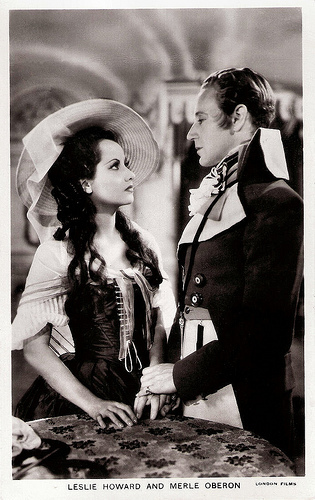
Leslie Howard and Merle Oberon . British postcard in the Film Partners Series, London, no. P 150. Photo: London Films. Publicity still for The Scarlet Pimpernel (Harold Young, 1934).
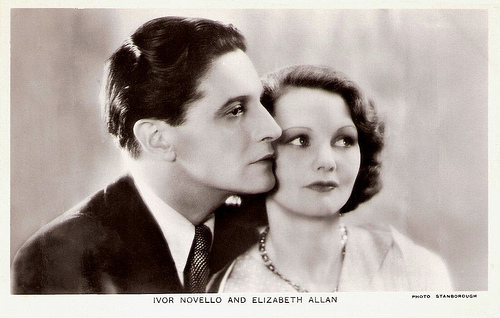
Ivor Novello and Elizabeth Allan . British postcard in the Film Partners series, London, no. P 41. Photo: Stanborough. Publicity still for The Lodger (Maurice Elvey, 1932).
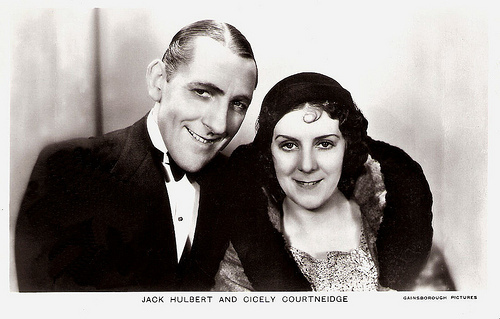
Jack Hulbert and Cicely Courtneidge . British postcard in the Film Partners Series, no. P 42. Photo: Gainsborough Pictures. Publicity still for Jack's the Boy (Walter Forde, 1932).
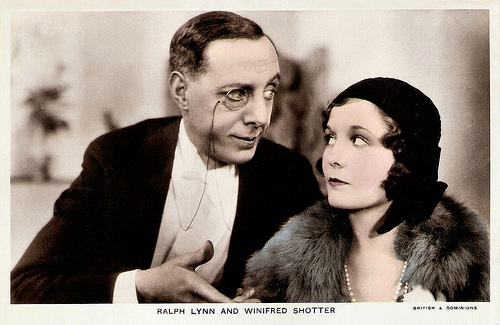
Ralph Lynn and Winifred Shotter . British postcard in the Film Partners series, London, no. 81. Photo: British & Dominions. Publicity still for Summer Lightning (Maclean Rogers, 1933).
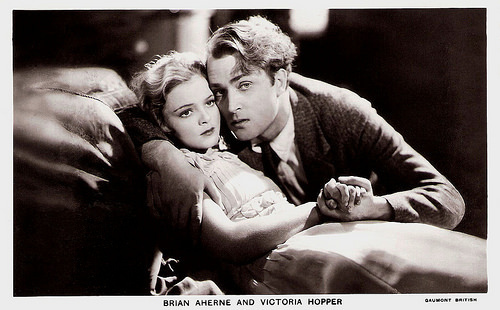
Brian Aherne and Victoria Hopper. British postcard in the Film Partners series, no. P 121. Photo: Gaumont-British. Publicity still for The Constant Nymph (Basil Dean, 1933).
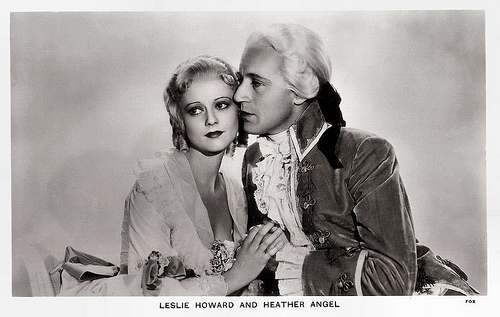
Leslie Howard and Heather Angel . British postcard in the Film Partners Series, London, no. P 123. Photo: Fox. Publicity still for Berkeley Square (Frank Lloyd, 1933).
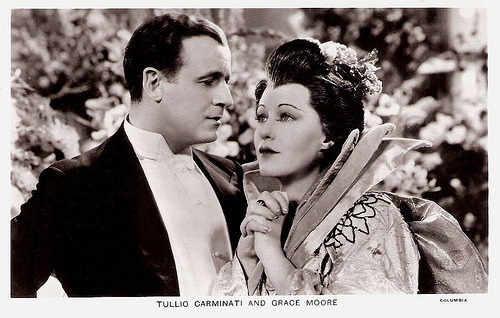
Tullio Carminati and Grace Moore. British postcard in the Film Partners Series, London, no. P 151. Photo: Columbia. Publicity still for One Night of Love (Victor Schertzinger, 1934).
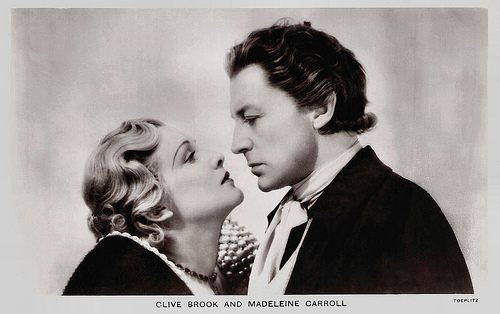
Madeleine Carroll and Clive Brook . British postcard in the Film Partners series, no. P 166. Photo: Toeplitz. Publicity still for The Dictator (Victor Saville, 1935).
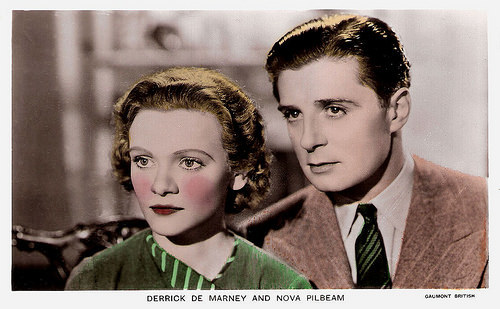
Derrick De Marney and Nova Pilbeam . British postcard in the Film Partners Series, no PC 236. Photo: Gaumont British. Publicity still for Young and Innocent/The Girl Was Young (Alfred Hitchcock, 1937).
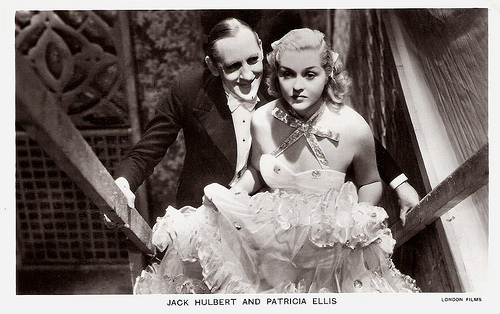
Jack Hulbert and Patricia Ellis. British postcard in the Film Partners Series, London, no. P 241. Photo: London Films. Publicity still for Paradise for Two/Gaiety Girls (Thornton Freeland, 1937).
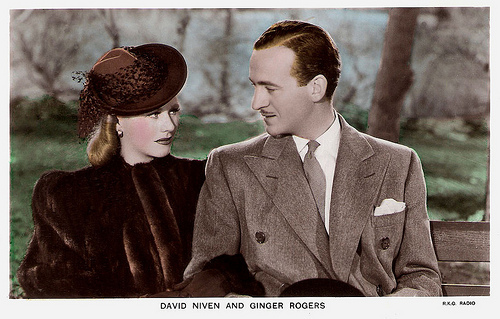
David Niven and Ginger Rodgers. British postcard in the Film Partners Series, London, no. PC 211. Photo: R.K.O. Radio. Publicity still for Bachelor Mother (Garson Kanin, 1939).
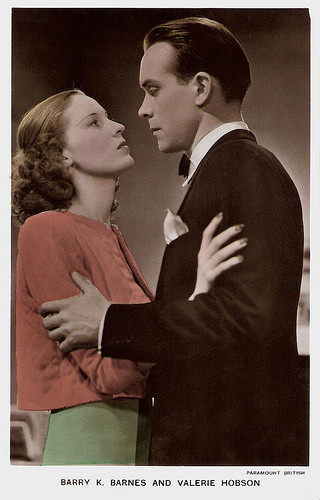
Barry K. Barnes and Valerie Hobson . British postcard in the Film Partners Series, no. PC 284. Photo: Paramount British. Publicity still for This Man in Paris (David MacDonald, 1939).
It is Postcard Friendship Friday, hosted by Beth at the The Best Hearts are Crunchy. You can visit her by clicking on the button below.


Leslie Howard and Merle Oberon . British postcard in the Film Partners Series, London, no. P 150. Photo: London Films. Publicity still for The Scarlet Pimpernel (Harold Young, 1934).

Ivor Novello and Elizabeth Allan . British postcard in the Film Partners series, London, no. P 41. Photo: Stanborough. Publicity still for The Lodger (Maurice Elvey, 1932).

Jack Hulbert and Cicely Courtneidge . British postcard in the Film Partners Series, no. P 42. Photo: Gainsborough Pictures. Publicity still for Jack's the Boy (Walter Forde, 1932).

Ralph Lynn and Winifred Shotter . British postcard in the Film Partners series, London, no. 81. Photo: British & Dominions. Publicity still for Summer Lightning (Maclean Rogers, 1933).

Brian Aherne and Victoria Hopper. British postcard in the Film Partners series, no. P 121. Photo: Gaumont-British. Publicity still for The Constant Nymph (Basil Dean, 1933).

Leslie Howard and Heather Angel . British postcard in the Film Partners Series, London, no. P 123. Photo: Fox. Publicity still for Berkeley Square (Frank Lloyd, 1933).

Tullio Carminati and Grace Moore. British postcard in the Film Partners Series, London, no. P 151. Photo: Columbia. Publicity still for One Night of Love (Victor Schertzinger, 1934).

Madeleine Carroll and Clive Brook . British postcard in the Film Partners series, no. P 166. Photo: Toeplitz. Publicity still for The Dictator (Victor Saville, 1935).

Derrick De Marney and Nova Pilbeam . British postcard in the Film Partners Series, no PC 236. Photo: Gaumont British. Publicity still for Young and Innocent/The Girl Was Young (Alfred Hitchcock, 1937).

Jack Hulbert and Patricia Ellis. British postcard in the Film Partners Series, London, no. P 241. Photo: London Films. Publicity still for Paradise for Two/Gaiety Girls (Thornton Freeland, 1937).

David Niven and Ginger Rodgers. British postcard in the Film Partners Series, London, no. PC 211. Photo: R.K.O. Radio. Publicity still for Bachelor Mother (Garson Kanin, 1939).

Barry K. Barnes and Valerie Hobson . British postcard in the Film Partners Series, no. PC 284. Photo: Paramount British. Publicity still for This Man in Paris (David MacDonald, 1939).
It is Postcard Friendship Friday, hosted by Beth at the The Best Hearts are Crunchy. You can visit her by clicking on the button below.

Published on November 23, 2017 22:00
November 22, 2017
Die goldene Krone (1920)
Henny Porten, Hermann Thimig and Paul Hartmann star in the German silent film Die goldene Krone/The Golden Crown (Alfred Halm, 1920), produced by Messter-Film GmbH. Ross Verlag presented this series of seven sepia postcards with scenes from the film. None of our usual sources offered a plot of the film, but in Die Freie Deutsche Bühne of 22 August 1920, we discovered a review by acclaimed author Joseph Roth.
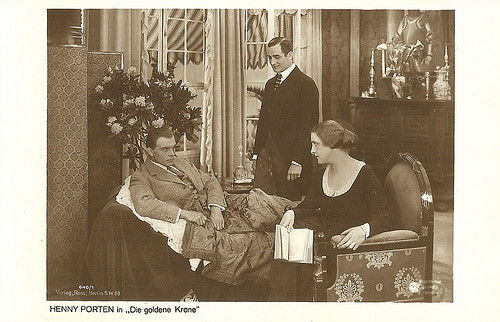
German postcard by Ross Verlag, no. 640/1. Photo: Messter. Publicity still of Henny Porten in Die goldene Krone (Alfred Halm, 1920).
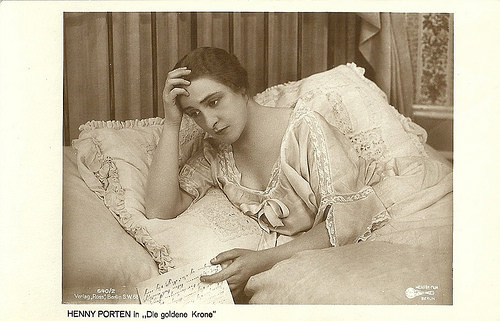
German postcard by Ross Verlag, no. 640/2. Photo: Messter. Publicity still of Henny Porten in Die goldene Krone (Alfred Halm, 1920).
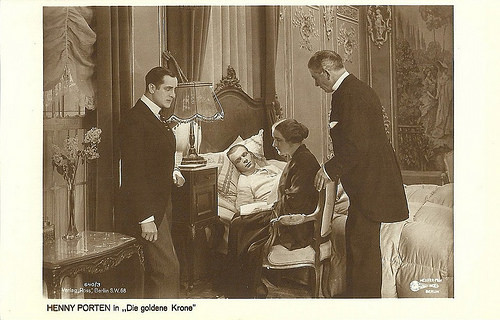
German postcard by Ross Verlag, no. 640/3. Photo: Messter. Publicity still of Henny Porten and Paul Hartmann in Die goldene Krone (Alfred Halm, 1920).
Nobody is guilty, it is just fate
In Die goldene Krone/The Golden Crown (1920), Henny Porten plays Marianne, daughter of the owner of the hotel Zur goldene Krone (At the Golden Crown). She loves a duke, Franz Günther ( Paul Hartmann ), who has tuberculosis and is mortally ill. To prevent the bankruptcy of his hotel, Marianne's father wants her to wed Klaus ( Hermann Thimig ), son of rich fish trader Stöven. Klaus, who is a good sport, is prepared to compromise and accepts her affair.
But as Joseph Roth writes in Die Freie Deutsche Bühne, Marianne breaks up 'betrothal, best wishes, wedding nights' and flees Klaus to take care of the dying duke, with all her efforts. However, the duke's family arrives and Marianne has to step back, right in the night when he dies. On his deathbed the duke commissions his aide-de-camp to marry Marianne, but the latter shoots himself because of the family. Marianne returns to her father's hotel to help it rise again. There Klaus returns to her and they marry at last.
Of course there is no proof about the reliability of Roth's plot description, and his negative final judgment might have influenced the rest of the text. In his introduction Roth stressed that Olga Wohlbrück, on whose story, published in Die Berliner Woche, the film was based, was a 'Courts-Mahler mit Niveau, und grammatikalischem Deutsch'. Wohlbrück's stories were popular among middle class women, as they always treated young women as protagonists who because of class difference could not marry their beloved aristocrats. Nobody is guilty, it is just fate. It is presented with credibility and cool detachement. Meanwhile the stories give insight in life in the higher classes.
Die goldene Krone had its first night in Berlin on 6 August 1920. The film was scripted by director Alfred Halm and Hans Bennert. Sets were by Ludwig Kainer and cinematography was by Willy Gaebel.
At the end of his critique, Joseph Roth, seriously condemned the film from his left-wing perspective: "Yet, I protest that today, on 7 August 1920, less than 2 years after the revolution, the world view of Die Woche is spread from cosy family circles to the masses by means of cinema. That 'fatzery' tragically works, because Olga Wohlbrück needs to live. I protest." Roth may have been overcharging it a bit, but it is indeed ambiguous that while the Weimar Republic in 1919 stripped the German nobility of all legal privileges and immunities, the aristocracy remained such a focus within the mainstream German cinema.
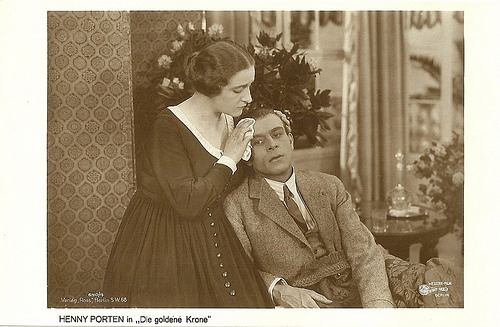
German postcard by Ross Verlag, no. 640/4. Photo: Messter. Publicity still of Henny Porten and Paul Hartmann in Die goldene Krone (Alfred Halm, 1920).
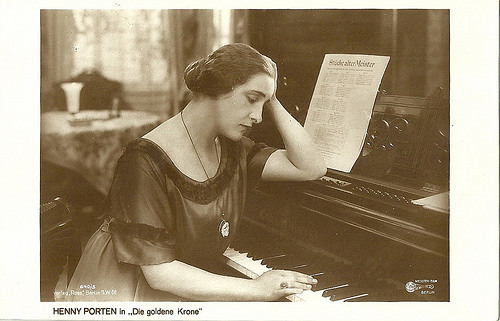
German postcard by Ross Verlag, no. 640/5. Photo: Messter. Publicity still of Henny Porten in Die goldene Krone (Alfred Halm, 1920).
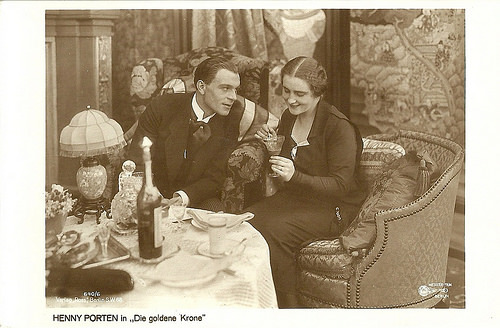
German postcard by Ross Verlag, no. 640/6. Photo: Messter. Publicity still of Henny Porten and Paul Hartmann in Die goldene Krone (Alfred Halm, 1920).
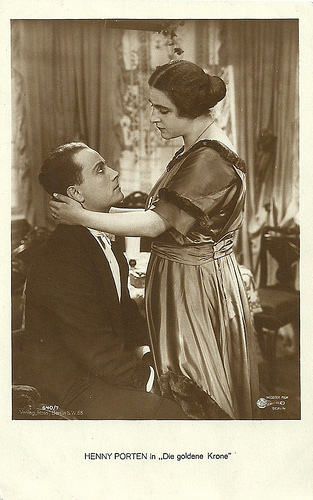
German postcard by Ross Verlag, no. 640/7. Photo: Messter. Publicity still of Henny Porten and Hermann Thimig in Die goldene Krone (Alfred Halm, 1920).
Sources: Joseph Roth (Die Freie Deutsche Bühne - German), Filmportal.de, Wikipedia, and IMDb.

German postcard by Ross Verlag, no. 640/1. Photo: Messter. Publicity still of Henny Porten in Die goldene Krone (Alfred Halm, 1920).

German postcard by Ross Verlag, no. 640/2. Photo: Messter. Publicity still of Henny Porten in Die goldene Krone (Alfred Halm, 1920).

German postcard by Ross Verlag, no. 640/3. Photo: Messter. Publicity still of Henny Porten and Paul Hartmann in Die goldene Krone (Alfred Halm, 1920).
Nobody is guilty, it is just fate
In Die goldene Krone/The Golden Crown (1920), Henny Porten plays Marianne, daughter of the owner of the hotel Zur goldene Krone (At the Golden Crown). She loves a duke, Franz Günther ( Paul Hartmann ), who has tuberculosis and is mortally ill. To prevent the bankruptcy of his hotel, Marianne's father wants her to wed Klaus ( Hermann Thimig ), son of rich fish trader Stöven. Klaus, who is a good sport, is prepared to compromise and accepts her affair.
But as Joseph Roth writes in Die Freie Deutsche Bühne, Marianne breaks up 'betrothal, best wishes, wedding nights' and flees Klaus to take care of the dying duke, with all her efforts. However, the duke's family arrives and Marianne has to step back, right in the night when he dies. On his deathbed the duke commissions his aide-de-camp to marry Marianne, but the latter shoots himself because of the family. Marianne returns to her father's hotel to help it rise again. There Klaus returns to her and they marry at last.
Of course there is no proof about the reliability of Roth's plot description, and his negative final judgment might have influenced the rest of the text. In his introduction Roth stressed that Olga Wohlbrück, on whose story, published in Die Berliner Woche, the film was based, was a 'Courts-Mahler mit Niveau, und grammatikalischem Deutsch'. Wohlbrück's stories were popular among middle class women, as they always treated young women as protagonists who because of class difference could not marry their beloved aristocrats. Nobody is guilty, it is just fate. It is presented with credibility and cool detachement. Meanwhile the stories give insight in life in the higher classes.
Die goldene Krone had its first night in Berlin on 6 August 1920. The film was scripted by director Alfred Halm and Hans Bennert. Sets were by Ludwig Kainer and cinematography was by Willy Gaebel.
At the end of his critique, Joseph Roth, seriously condemned the film from his left-wing perspective: "Yet, I protest that today, on 7 August 1920, less than 2 years after the revolution, the world view of Die Woche is spread from cosy family circles to the masses by means of cinema. That 'fatzery' tragically works, because Olga Wohlbrück needs to live. I protest." Roth may have been overcharging it a bit, but it is indeed ambiguous that while the Weimar Republic in 1919 stripped the German nobility of all legal privileges and immunities, the aristocracy remained such a focus within the mainstream German cinema.

German postcard by Ross Verlag, no. 640/4. Photo: Messter. Publicity still of Henny Porten and Paul Hartmann in Die goldene Krone (Alfred Halm, 1920).

German postcard by Ross Verlag, no. 640/5. Photo: Messter. Publicity still of Henny Porten in Die goldene Krone (Alfred Halm, 1920).

German postcard by Ross Verlag, no. 640/6. Photo: Messter. Publicity still of Henny Porten and Paul Hartmann in Die goldene Krone (Alfred Halm, 1920).

German postcard by Ross Verlag, no. 640/7. Photo: Messter. Publicity still of Henny Porten and Hermann Thimig in Die goldene Krone (Alfred Halm, 1920).
Sources: Joseph Roth (Die Freie Deutsche Bühne - German), Filmportal.de, Wikipedia, and IMDb.
Published on November 22, 2017 22:00
November 21, 2017
Katja Riemann
German actress and singer Katja Riemann (1963) was a major star of the German cinema of the 1990s, who appeared in such international successful films as Der bewegte Mann (1994) and Comedian Harmonists (1997). Riemann also often worked with the directors Katja von Garnier and Margaretha von Trotta.

German postcard by Franz Josef Rüdel, Filmpostkartenverlag, Hamburg. Photo: Mathias Bothor.
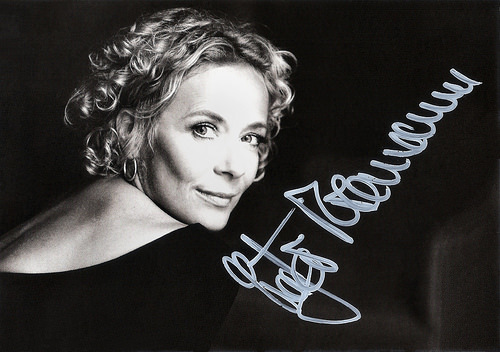
German postcard by Katja Riemann.de. Photo: Mirjam Knickriem.
The biggest grossing homegrown film
Katja Hannchen Leni Riemann was born in 1963 in Weyhe-Kirchweyhe, Germany. She is the daughter of two teachers and she has a sister, Susanne, and a brother, Jochen.
Riemann grew up in Weyhe, near Bremen. After high school she went to study at the School of Theatre and Music in Hanover from 1984 to 1986 and the Otto Falckenberg Drama School in Munich from 1986 to 1987. She attended the Westphalian Landestheater in Castrop-Rauxel and came to the ensemble of the Münchner Kammerspiele before the end of her training.
She made her screen debut in the TV mini-series Sommer in Lesmona/Summer in Lesmona (Peter Beauvais, 1985-1986). For her role she won two awards. After this success, several TV roles followed, including the title role in the series Regina auf den Stufen (Bernd Fischerauer, 1992) with Mark Kuhn and Serge Avedikian.
She had her breakthrough in the cinema with Abgeschminkt!/Making Up! (Katja von Garnier, 1993) opposite Max Tidof. The film is a satire about women of the 1990s in search of the men of their dreams.
The following year, she appeared as the girlfriend of Til Schweiger in the hilarious romantic comedy Der bewegte Mann/ Maybe, maybe not (Sönke Wortmann, 1994), also with Joachim Król. The comedy was based on the gay comics by Ralf König. At the time of its release, this was the biggest grossing homegrown film at the German box office. Other comedies followed like Nur über meine Leiche/Over My Dead Body (Rainer Matsutani, 1995).
Riemann reunited with director Katja von Garnier for the road movie Bandits (Katja von Garnier, 1997) with Jutta Hoffmann. The story is about members of a female rock band who escape from prison. Riemann even learned to play the drums for her role. Both the film and soundtrack album were commercially successful in Germany, and Riemann won the Deutscher Filmpreis (German Film Award) for her role.
With director Rainer Kaufmann, she made the films Stadtgespräch/Talk of the Town (Rainer Kaufmann, 1995) with Martina Gedeck and Kai Wiesinger, and the comedy Die Apothekerin/The Pharmacist (Rainer Haufmann, 1997) with Jürgen Vogel and August Zirner. An international success was Comedian Harmonists (Joseph Vilsmaier, 1997) about the legendary close harmony sextet, played by a.o. Ben Becker, Kai Wiesinger and Max Tidof.
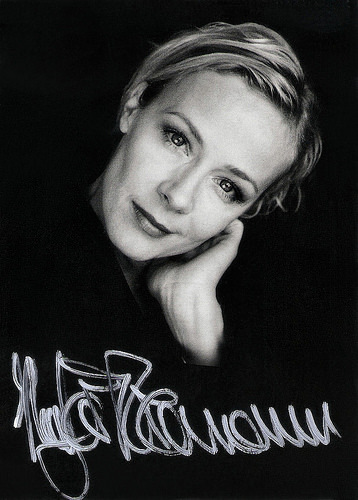
German postcard by Franz Josef Rüdel, Filmpostkartenverlag, Hamburg. Photo: Stefan May.
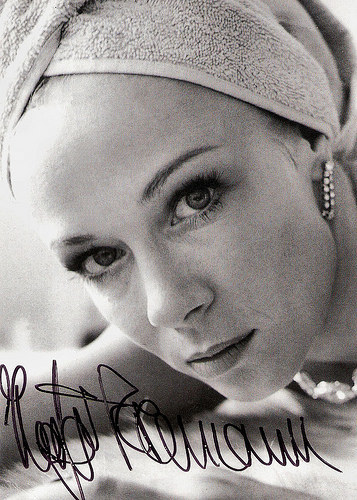
German postcard by Franz Josef Rüdel, Filmpostkartenverlag, Hamburg. Photo: Stefan May, München.
I Am the Other Woman
Beside her acting career, Katja Riemann started singing and released her first album Nachtblende in 2000. In 2003, the English-language jazz album Favourites followed with the Katja Riemann octet.
In the cinema she appeared in the pan-European production Novel (Fabio Carpi, 2001) starring Hector Alterio. She starred with Maria Schrader in the film Rosenstraße (Margarethe von Trotta, 2003) about the Rosenstrasse protest where women waited for seven days and nights outside of a Nazi jail for their Jewish husbands. The protests took place in Berlin during the winter of 1943. In Italy, the film won a David at the David di Donatello Awards.
With Von Trotta, she also worked on the psychodrama Ich bin die Andere/I Am the Other Woman (Margarethe von Trotta, 2006) with Armin Mueller-Stahl and Karin Dor . She played with Moritz Bleibtreu in the drama Agnes und seine Brüder/Agnes & His Brothers (Oskar Roehler, 2004).
With Von Garnier, she made an international production Blood and Chocolate (Katja von Garnier, 2007) with Hugh Dancy and Olivier Martinez, but it was a flop. More interesting was the Swiss-German rural drama Der Verdingbub/The Foster Boy (Markus Imboden, 2011). Filmportal.de : “she gives a stunning performance as a cold-hearted farmer, who holds an orphan boy like a slave on her yard.”
A huge box office success was the comedy Fack ju Göhte/Suck Me Shakespeer (Bora Dagtekin, 2013) starring Elyas M'Barek. Riemann played a strict school principal and received for her performance a Best Supporting Actress Nomination at the 2014 German Film Award.
In the drama Die abhandene Welt/The Misplaced World (Margaretha von Trotta, 2015) she co-starred with Barbara Sukowa and Mathias Habich. She also had a small part in the Hitler-in the-21st-century comedy Er ist wieder da/Look Who's Back (David Wnendt, 2015).
At the moment of writing, several films with her are in production, including Fack ju Göhte 3/Suck Me Shakespeer 3 (Bora Dagtekin, 2017), the comedy Forget About Nick (Margaretha von Trotta, 2017) and Subs (Oskar Roehler, 2018).
Katja Riemann is the mother of actress Paula Riemann (also Paula Romy), whose father is Peter Sattmann. Riemann met Sattmann, on the set of Von Gewalt keine Rede (1991), and they had a relationship from 1990 to 1998. Since 2007, she has been the longtime companion of sculptor Raphael Alexander Beil.
Riemann won the Bavarian Film Award three times. Twice as Best Actress in 1993 and 1995, and once for the Best Film Score in 1997. She wrote two successful children`s books, Der Name der Sonne (The name of the sun) and Der Chor der Engel (The choir of the angels), together with her sister Susanne (2002).

German postcard by Franz Josef Rüdel, Filmpostkartenverlag, Hamburg. Photo: Jim Rakete / Photo Selection.
German trailer Abgeschminkt!/Making Up! (1993). Source: alleskino (YouTube).
International trailer for Der bewegte Mann/ Maybe, maybe not (1994). Source: Video Detective (YouTube).
Sources: Filmportal.de, Wikipedia (English and German), and .

German postcard by Franz Josef Rüdel, Filmpostkartenverlag, Hamburg. Photo: Mathias Bothor.

German postcard by Katja Riemann.de. Photo: Mirjam Knickriem.
The biggest grossing homegrown film
Katja Hannchen Leni Riemann was born in 1963 in Weyhe-Kirchweyhe, Germany. She is the daughter of two teachers and she has a sister, Susanne, and a brother, Jochen.
Riemann grew up in Weyhe, near Bremen. After high school she went to study at the School of Theatre and Music in Hanover from 1984 to 1986 and the Otto Falckenberg Drama School in Munich from 1986 to 1987. She attended the Westphalian Landestheater in Castrop-Rauxel and came to the ensemble of the Münchner Kammerspiele before the end of her training.
She made her screen debut in the TV mini-series Sommer in Lesmona/Summer in Lesmona (Peter Beauvais, 1985-1986). For her role she won two awards. After this success, several TV roles followed, including the title role in the series Regina auf den Stufen (Bernd Fischerauer, 1992) with Mark Kuhn and Serge Avedikian.
She had her breakthrough in the cinema with Abgeschminkt!/Making Up! (Katja von Garnier, 1993) opposite Max Tidof. The film is a satire about women of the 1990s in search of the men of their dreams.
The following year, she appeared as the girlfriend of Til Schweiger in the hilarious romantic comedy Der bewegte Mann/ Maybe, maybe not (Sönke Wortmann, 1994), also with Joachim Król. The comedy was based on the gay comics by Ralf König. At the time of its release, this was the biggest grossing homegrown film at the German box office. Other comedies followed like Nur über meine Leiche/Over My Dead Body (Rainer Matsutani, 1995).
Riemann reunited with director Katja von Garnier for the road movie Bandits (Katja von Garnier, 1997) with Jutta Hoffmann. The story is about members of a female rock band who escape from prison. Riemann even learned to play the drums for her role. Both the film and soundtrack album were commercially successful in Germany, and Riemann won the Deutscher Filmpreis (German Film Award) for her role.
With director Rainer Kaufmann, she made the films Stadtgespräch/Talk of the Town (Rainer Kaufmann, 1995) with Martina Gedeck and Kai Wiesinger, and the comedy Die Apothekerin/The Pharmacist (Rainer Haufmann, 1997) with Jürgen Vogel and August Zirner. An international success was Comedian Harmonists (Joseph Vilsmaier, 1997) about the legendary close harmony sextet, played by a.o. Ben Becker, Kai Wiesinger and Max Tidof.

German postcard by Franz Josef Rüdel, Filmpostkartenverlag, Hamburg. Photo: Stefan May.

German postcard by Franz Josef Rüdel, Filmpostkartenverlag, Hamburg. Photo: Stefan May, München.
I Am the Other Woman
Beside her acting career, Katja Riemann started singing and released her first album Nachtblende in 2000. In 2003, the English-language jazz album Favourites followed with the Katja Riemann octet.
In the cinema she appeared in the pan-European production Novel (Fabio Carpi, 2001) starring Hector Alterio. She starred with Maria Schrader in the film Rosenstraße (Margarethe von Trotta, 2003) about the Rosenstrasse protest where women waited for seven days and nights outside of a Nazi jail for their Jewish husbands. The protests took place in Berlin during the winter of 1943. In Italy, the film won a David at the David di Donatello Awards.
With Von Trotta, she also worked on the psychodrama Ich bin die Andere/I Am the Other Woman (Margarethe von Trotta, 2006) with Armin Mueller-Stahl and Karin Dor . She played with Moritz Bleibtreu in the drama Agnes und seine Brüder/Agnes & His Brothers (Oskar Roehler, 2004).
With Von Garnier, she made an international production Blood and Chocolate (Katja von Garnier, 2007) with Hugh Dancy and Olivier Martinez, but it was a flop. More interesting was the Swiss-German rural drama Der Verdingbub/The Foster Boy (Markus Imboden, 2011). Filmportal.de : “she gives a stunning performance as a cold-hearted farmer, who holds an orphan boy like a slave on her yard.”
A huge box office success was the comedy Fack ju Göhte/Suck Me Shakespeer (Bora Dagtekin, 2013) starring Elyas M'Barek. Riemann played a strict school principal and received for her performance a Best Supporting Actress Nomination at the 2014 German Film Award.
In the drama Die abhandene Welt/The Misplaced World (Margaretha von Trotta, 2015) she co-starred with Barbara Sukowa and Mathias Habich. She also had a small part in the Hitler-in the-21st-century comedy Er ist wieder da/Look Who's Back (David Wnendt, 2015).
At the moment of writing, several films with her are in production, including Fack ju Göhte 3/Suck Me Shakespeer 3 (Bora Dagtekin, 2017), the comedy Forget About Nick (Margaretha von Trotta, 2017) and Subs (Oskar Roehler, 2018).
Katja Riemann is the mother of actress Paula Riemann (also Paula Romy), whose father is Peter Sattmann. Riemann met Sattmann, on the set of Von Gewalt keine Rede (1991), and they had a relationship from 1990 to 1998. Since 2007, she has been the longtime companion of sculptor Raphael Alexander Beil.
Riemann won the Bavarian Film Award three times. Twice as Best Actress in 1993 and 1995, and once for the Best Film Score in 1997. She wrote two successful children`s books, Der Name der Sonne (The name of the sun) and Der Chor der Engel (The choir of the angels), together with her sister Susanne (2002).

German postcard by Franz Josef Rüdel, Filmpostkartenverlag, Hamburg. Photo: Jim Rakete / Photo Selection.
German trailer Abgeschminkt!/Making Up! (1993). Source: alleskino (YouTube).
International trailer for Der bewegte Mann/ Maybe, maybe not (1994). Source: Video Detective (YouTube).
Sources: Filmportal.de, Wikipedia (English and German), and .
Published on November 21, 2017 22:00
November 20, 2017
Annie Vernay
Pretty little Annie Vernay (1921-1941) catapulted into stardom at an early age, but the career of the Swiss-French actress was cut short. She died only 19 years old.
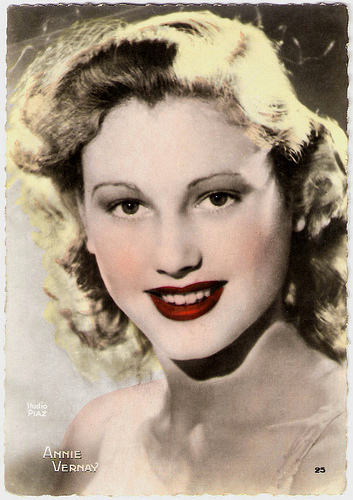
French postcard by Editions P.I., Paris, no. 25. Photo: Teddy Piaz.
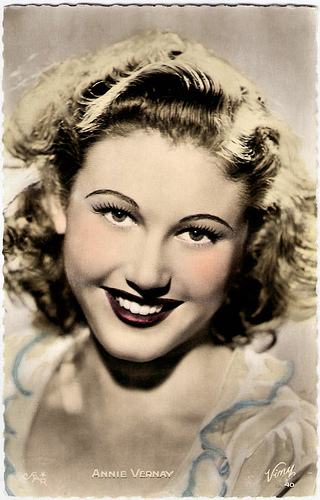
French postcard by Viny, no. 40. Photo: Star. With an autograph by Vernay at the flipside, dated 11 May 1940.
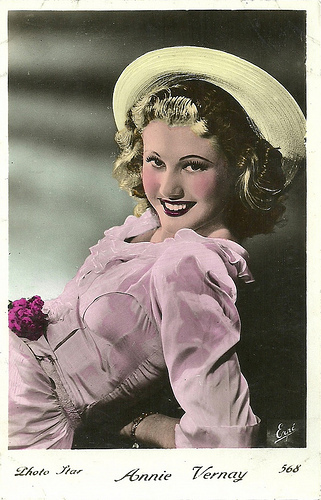
French postcard by Erpé, no. 568. Photo: Star.
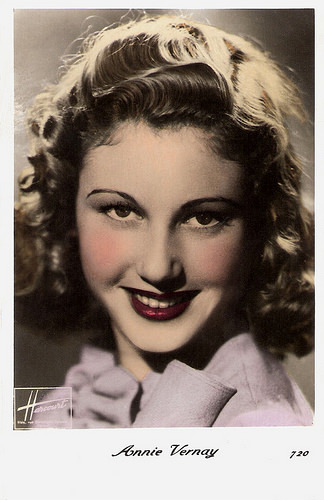
French postcard, no. 720. Photo: Harcourt.
Pushing Mother
Annie Vernay was born Annie-Martine-Jacqueline Vermeersch in Genève-Plainpalais, Switzerland, in 1921. Her father, Gaston Vermeersch, was a rich industrialist.
As her mother Germaine Vermeersch couldn't realise an artistic career because of her marriage de raison, she pushed her daughter into an artistic career after her husband died and she inherited his fortune. She applied her daughter for Jugement d’Hélène, a beauty contest in Paris, when the girl was 16 years old.
During holidays at Juan les Pins a friend of film director Victor Tourjansky spotted her and recommended her to him. Tourjansky engaged her for the role of Lisl in his film Le mensonge de Nina Petrovna/The Lie of Nina Petrovna (Victor Tourjansky, 1937), which starred Italian star Isa Miranda and Fernand Gravey . The film had been shot earlier in Germany as Die wunderbare Lüge der Nina Petrowna (Hanns Schwarz, 1929) with Brigitte Helm .
Vernay did so well that she was cast as the leading actress in the Italo-French multilingual La principessa Tarakanova/Betrayal (1938), shot at Cinecittà in Rome and directed by Russian director Fyodor Otsep and the Italian Mario Soldati.
Vernay played a princess who claims the Russian throne. Empress Catherine II ( Suzy Prim ) sends her lover and best soldier Orloff ( Pierre-Richard Willm ) to capture the impostor, but he falls for her beauty and innocence. The film had lavish sets of Venice and St. Petersburg and was one of the first Italian films shot in deep focus. It was a box office hit in 1938.
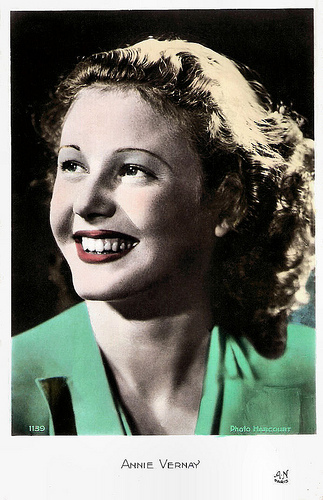
French postcard by A.N., Paris, no. 1139. Photo: Harcourt.
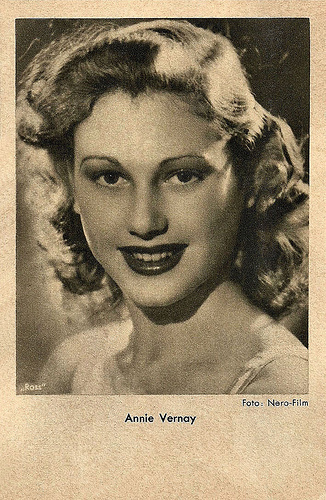
German postcard by Ross. Photo: Nero-Film.
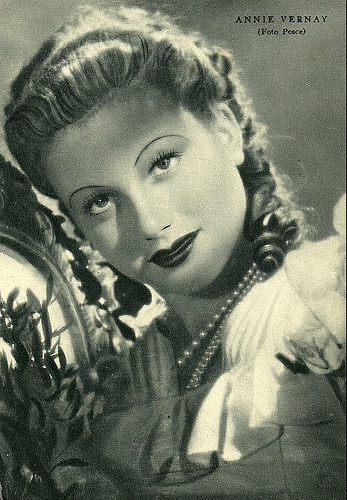
Italian postcard by Rizzoli, Milano, 1938, XVI. Photo: Pesce.
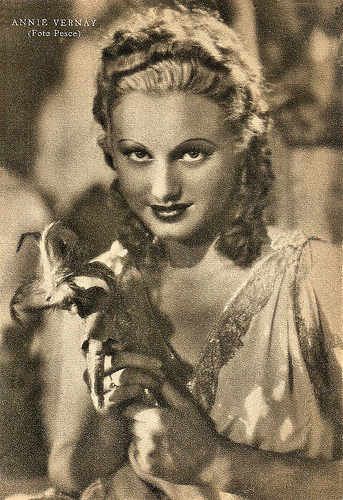
Italian postcard by Rizzoli, Milano. Photo: Pesce.
Rick's Café
Annie Vernay’s mother, who had become her agent and coach as well, knew she had gold in her hands. Annie herself, more sober, continued her studies in between shootings. The result was that the famous producer Seymour Nebenzahl of Nero Film engaged Vernay for several films.
The first was Max Ophüls’ adaptation of Johann Wolfgang Goethe’s Die Leiden des jungen Werthers: Le roman de Werther/Sorrow of Werther (Max Ophüls, 1938). It featured Pierre-Richard Willm as Werther and Vernay as Charlotte/Lotte, the girl for whom Werther commits suicide. The film confirmed Vernay’s status as a new French film star, competing with young stars like Danielle Darrieux .
When World War II broke out in the summer of 1939, French film production hesitated but still continued, enabling Vernay to play in more films: the World War One drama Les otages/The Mayor's Dilemma (Raymond Bernard, 1939) with Pierre Larquey, Dédé la musique/Dédé of Montmartre (André Berthomieu, 1939) with Albert Préjean , Chantons quand même/Let us sing all the same (Pierre Caro, 1940), and the crime film Le collier de chanvre/Hangman's Noose (Léon Mathot, 1940) with Jacqueline Delubac .
Because of the pending German invasion of France, Annie Vernay intended to return to Switzerland, but at that moment she received an offer from Hollywood to play the role of a foreign woman in a movie called Rick's Café. Annie’s mother convinced her to accept the offer, so they travelled to the US via Argentine, on one of the last freighters to leave France.
Aboard the ship, though, Annie fell ill of typhoid and died in a hospital after her arrival in Buenos Aires, in August 1941. Annie Vernay was only 19 years old. Germaine Vermeersch never got over the loss of her daughter.
Other candidates for the same role in Rick's Café had been Hedy Lamarr and Michèle Morgan but eventually it would give Ingrid Bergman everlasting fame. The film in which Annie Vernay was supposed to play the female lead was later filmed as Casablanca (Michael Curtiz, 1942).
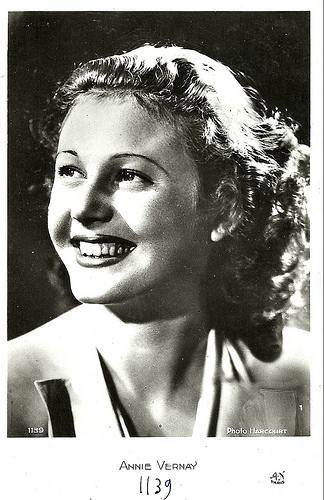
French postcard by A.N., Paris, no. 1139 Photo: Harcourt.
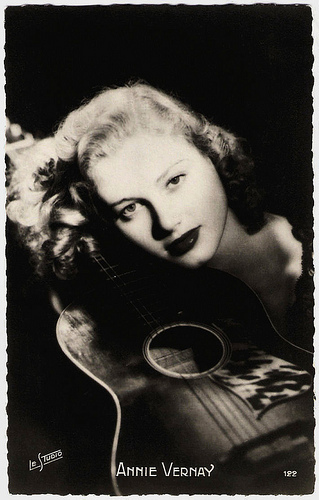
French postcard by O.P., Paris, no. 122. Photo: Le Studio.
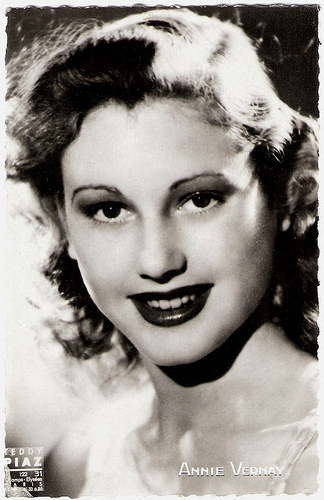
French postcard by P.I., Paris. Photo: Teddy Piaz.
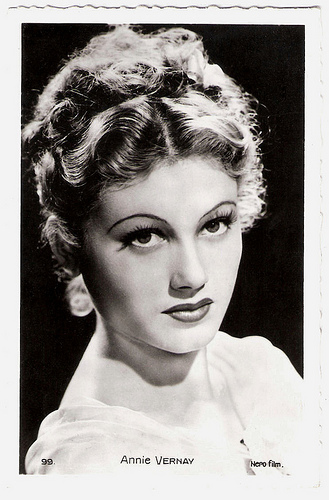
French postcard by Collection Chantal, Paris. Photo: Nero Film.
Sources: Thomas Staedeli (Cyranos), Cine Vedette (French), Caroline Hanotte & Philippe Pelletier (CinéArtistes), and .

French postcard by Editions P.I., Paris, no. 25. Photo: Teddy Piaz.

French postcard by Viny, no. 40. Photo: Star. With an autograph by Vernay at the flipside, dated 11 May 1940.

French postcard by Erpé, no. 568. Photo: Star.

French postcard, no. 720. Photo: Harcourt.
Pushing Mother
Annie Vernay was born Annie-Martine-Jacqueline Vermeersch in Genève-Plainpalais, Switzerland, in 1921. Her father, Gaston Vermeersch, was a rich industrialist.
As her mother Germaine Vermeersch couldn't realise an artistic career because of her marriage de raison, she pushed her daughter into an artistic career after her husband died and she inherited his fortune. She applied her daughter for Jugement d’Hélène, a beauty contest in Paris, when the girl was 16 years old.
During holidays at Juan les Pins a friend of film director Victor Tourjansky spotted her and recommended her to him. Tourjansky engaged her for the role of Lisl in his film Le mensonge de Nina Petrovna/The Lie of Nina Petrovna (Victor Tourjansky, 1937), which starred Italian star Isa Miranda and Fernand Gravey . The film had been shot earlier in Germany as Die wunderbare Lüge der Nina Petrowna (Hanns Schwarz, 1929) with Brigitte Helm .
Vernay did so well that she was cast as the leading actress in the Italo-French multilingual La principessa Tarakanova/Betrayal (1938), shot at Cinecittà in Rome and directed by Russian director Fyodor Otsep and the Italian Mario Soldati.
Vernay played a princess who claims the Russian throne. Empress Catherine II ( Suzy Prim ) sends her lover and best soldier Orloff ( Pierre-Richard Willm ) to capture the impostor, but he falls for her beauty and innocence. The film had lavish sets of Venice and St. Petersburg and was one of the first Italian films shot in deep focus. It was a box office hit in 1938.

French postcard by A.N., Paris, no. 1139. Photo: Harcourt.

German postcard by Ross. Photo: Nero-Film.

Italian postcard by Rizzoli, Milano, 1938, XVI. Photo: Pesce.

Italian postcard by Rizzoli, Milano. Photo: Pesce.
Rick's Café
Annie Vernay’s mother, who had become her agent and coach as well, knew she had gold in her hands. Annie herself, more sober, continued her studies in between shootings. The result was that the famous producer Seymour Nebenzahl of Nero Film engaged Vernay for several films.
The first was Max Ophüls’ adaptation of Johann Wolfgang Goethe’s Die Leiden des jungen Werthers: Le roman de Werther/Sorrow of Werther (Max Ophüls, 1938). It featured Pierre-Richard Willm as Werther and Vernay as Charlotte/Lotte, the girl for whom Werther commits suicide. The film confirmed Vernay’s status as a new French film star, competing with young stars like Danielle Darrieux .
When World War II broke out in the summer of 1939, French film production hesitated but still continued, enabling Vernay to play in more films: the World War One drama Les otages/The Mayor's Dilemma (Raymond Bernard, 1939) with Pierre Larquey, Dédé la musique/Dédé of Montmartre (André Berthomieu, 1939) with Albert Préjean , Chantons quand même/Let us sing all the same (Pierre Caro, 1940), and the crime film Le collier de chanvre/Hangman's Noose (Léon Mathot, 1940) with Jacqueline Delubac .
Because of the pending German invasion of France, Annie Vernay intended to return to Switzerland, but at that moment she received an offer from Hollywood to play the role of a foreign woman in a movie called Rick's Café. Annie’s mother convinced her to accept the offer, so they travelled to the US via Argentine, on one of the last freighters to leave France.
Aboard the ship, though, Annie fell ill of typhoid and died in a hospital after her arrival in Buenos Aires, in August 1941. Annie Vernay was only 19 years old. Germaine Vermeersch never got over the loss of her daughter.
Other candidates for the same role in Rick's Café had been Hedy Lamarr and Michèle Morgan but eventually it would give Ingrid Bergman everlasting fame. The film in which Annie Vernay was supposed to play the female lead was later filmed as Casablanca (Michael Curtiz, 1942).

French postcard by A.N., Paris, no. 1139 Photo: Harcourt.

French postcard by O.P., Paris, no. 122. Photo: Le Studio.

French postcard by P.I., Paris. Photo: Teddy Piaz.

French postcard by Collection Chantal, Paris. Photo: Nero Film.
Sources: Thomas Staedeli (Cyranos), Cine Vedette (French), Caroline Hanotte & Philippe Pelletier (CinéArtistes), and .
Published on November 20, 2017 22:00
November 19, 2017
Roldano Lupi
Roldano Lupi (1909-1989) was an acclaimed Italian actor of cinema, television and theatre. Despite being the leading man of many successful films of the 1930s and 1940s, he was never considered a true star by the public.
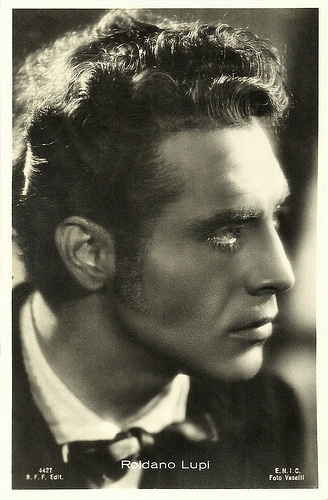
Italian postcard. Ed. Ballerini & Fratini, Firenze (B.F.F. Edit.), no. 1427. Photo: Vaselli / E.N.I.C.
Jealousy
Roldano Lupi was born in Milan in 1909, as son of Domenico and Maria Tardiani.
He earned a degree as accountant in Milan, and later dedicated himself to acting for sheer delight, becoming part of the cast of some local amateur stage companies.
His transition to professional acting took place relatively late in 1938, when he had the opportunity to enter the celebrated Kiki Palmer company. After this, his career underwent a strong acceleration. He first moved to the company of Guglielmo Giannini, and in 1942 to that of Ruggero Ruggeri and Dina Galli .
In the meantime, Lupi started his career in the cinema. In 1941 he made his film debut in the romance Sissignora/Yes, Madam, directed by Ferdinando Maria Poggioli – whose favourite actor he became. Here he played the role that made him famous, that of the selfish and cynical lover, of Evi Maltagliati in this case, who plays the employer of the protagonist Cristina ( Maria Denis ).
More success came to Lupi the following year, as the protagonist of the drama Gelosia/Jealousy (Ferdinando Maria Poggioli, 1942). Here he is a marquis who weds his love interest, a farmer girl ( Luisa Ferida ), to one of his tenants, with the promise the marriage may not be consumed. He shoots the tenant out of jealousy. He confesses his crime to a priest but refuses to denounce himself, hiding in a wedding with a noble lady. Too late, he repents his mistakes.
In 1943-1944, he worked on the film Circo equestre Za-bum/The Za-Bum Circus (Mario Mattoli, 1944). The film was shot clandestinely in Rome during the Italian Social Republic also known as the Republic of Salò (1943-1945), when the country was occupied by the Germans and all cinematic activity was transferred to Venice. Many actors and technicians decided to stay in Rome, some with work permits delivered by the Vatican State, and the not so lucky - like those involved in this film - working clandestinely.
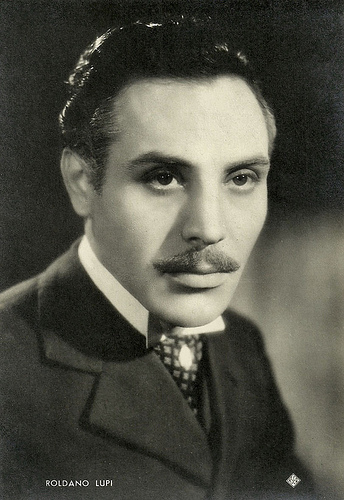
Italian postcard by ASER (A. Scaramaglia Edizioni Roma), no. 353. Photo: Civirani / Lux Film.
Seriousness and professionalism
From that time until the immediate post-war period, Roldano Lupi became one of the leading men of the Italian cinema. He characterised his interpretations with seriousness and professionalism. This earned him strong acclaim by the critics, who, however, sometimes criticised him for sometimes too fixed kinds of expressions.
During the war, Lupi acted in Nessuno orna indietro/Responsibility Comes Back (Alessandro Blasetti, 1943), Il cappello da prete/The priest's hat (Ferdinando Maria Poggioli, 1944) and La porta del cielo/The Gates of Heaven (Vittorio De Sica, 1944). The latter film is the story of a train full of sick and deformed pilgrims on their way to seek miracles at the shrine of Our Lady of Loreto, near the city of Ancona in eastern Italy. La porta del cielo was made during the German occupation of Rome, with support from the Vatican. This allowed Lupi and other actors, under pressure to go north and work in Venice for the film industry of Mussolini's Italian Social Republic, to remain in Rome.
Lupi was equipped with a face with a thick and frowning expression. So, despite being the leading man of many successful films, he was never considered a true star by the public who rather favoured actors like Massimo Girotti , Amedeo Nazzari , Fosco Giachetti , and Andrea Checchi , even if at times they played parts similar to his own.
Precisely the roles he was constrained to - the jealous and crazy lover, the perverted and unwilling nobleman ready for money, the disturbed assassin - became in some respects Lupi’s professional strength. The expression to the limits of the madness that he was able to infuse his characters, and the cloudy air around him signed him deeply, but in other respects these features also limited his career and popularity.
In the postwar period, he was remarkable in the crime film Il testimone/The Testimony (Pietro Germi, 1945) with Marina Berti , L'adultera/The Adulteress (Duilio Coletti, 1946) with Clara Calamai , Il delitto di Giovanni Episcopo/Flesh Will Surrender (Alberto Lattuada 1947), and Altura/Height (Mario Sequi 1949), alongside Mario Girotti and Eleonora Rossi Drago .
In 1950, he appeared in L'edera/Devotion (Augusto Genina 1950) opposite Columba Dominguez, who plays a girl, adopted by a declining aristocratic family. This Italian rural drama was shot in Barbagia, Sardinia. Vitaliano Brancati contributed to the script, based on a novel by Grazia Deledda. The film quite closely follows the novel, which takes place on the province of Nuoro, but offers a less drastic finale. Progressively, in the second half of the 1950s, Lupi was increasingly employed in character roles.
In 1944, he had returned to the theatre. First he worked with the Magnani Ninchi company, then in 1947, with only Carlo Ninchi . He later became the protagonist of the great Medea summer show in 1949. In 1951, with the company of Guido Salvini, he continued his activity on the stage, starting also as radio and voice actor. He dubbed Walter Pidgeon in the cult film Forbidden Planet (Fred Wilcox, 1956), but also Leo Genn , George Montgomery and the famous western film actor Roy Rogers.

Italian postcard by Ed. Mondadori. Photo: Cines / E.N.I.C. / AGAR. Columba Dominguez and Roldano Lupi in L'edera/Devotion (Augusto Genina, 1950).
Peplum
Even in the 1960s, Roldano Lupi continued to work in the cinema in many genres, even as a leading man in a Peplum. He worked with such directors as Riccardo Freda, Domenico Paolella, Primo Zeglio, Umberto Scarpelli and other specialists.
Yet, he also took the pleasure of shooting films with French filmmakers like Claude Autant-Lara, Christian-Jaque, Bernard Borderie and Henri Decoin. He was Captain De Treville in I cavalieri della regina (1954), co-directed by Mauro Bolognini and Joseph Lerner and based on Alexandre Dumas' The Three Musketeers.
In 1952, he also had the opportunity to be a partner of Hollywood star Errol Flynn in Il maestro di Don Giovanni/Crossed Swords (Milton Krims, 1952). Lupi's last film part was in the Peplum film La vendetta dei gladiatori/Revenge of the Gladiators (Luigi Capuano, 1964)
With the emergence of television, Lupi's commitments gradually shifted from the big to the small screen, such as in Mont Oriol (Claudio Fino, 1958), L'isola del tesoro/Treasure Island (Anton Giulio Majano, 1959), Tom Jones (Eros Macchi, 1960), Una tragedia americana/An American Tragedy (Anton Giulio Majano, 1962), La sciarpa/The Scarf (Guglielmo Morandi, 1963), I miserabili/Les Miserables (Sandro Bolchi, 1964), and David Copperfield (Anton Giulio Majano, 1965).
In the same year he took part in Questa sera parla Mark Twain/This evening speaks Mark Twain (Daniele D'Anza, 1965), starring Paolo Stoppa . He was also in other TV dramas including Le mie prigioni/My prisons (Sandro Bolchi, 1968) and Eleonora (Silverio Blasi, 1973). His intense stage and TV career lasted until 1979 when he appeared for the last time in an episode of the TV series Racconti di fantascienza/Science fiction stories by Alessandro Blasetti.
Roldano Lupi was married to the Venetian stage actress Pina Bertoncello. He died in Rome in 1989, and lies buried in the Cimitero Flaminio in Rome.
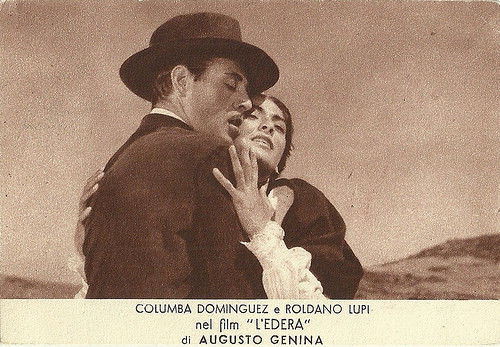
Italian postcard by Ed. Mondadori. Photo: Cines / E.N.I.C. / AGAR. Columba Dominguez and Roldano Lupi in L'edera/Devotion (Augusto Genina, 1950).
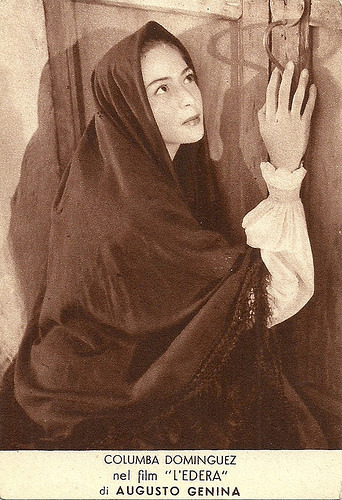
Italian postcard by Ed. Mondadori. Photo: Cines / E.N.I.C. / AGAR. Columba Dominguez in L'edera/Devotion (Augusto Genina, 1950).
Sources: Wikipedia (Italian and English) and .

Italian postcard. Ed. Ballerini & Fratini, Firenze (B.F.F. Edit.), no. 1427. Photo: Vaselli / E.N.I.C.
Jealousy
Roldano Lupi was born in Milan in 1909, as son of Domenico and Maria Tardiani.
He earned a degree as accountant in Milan, and later dedicated himself to acting for sheer delight, becoming part of the cast of some local amateur stage companies.
His transition to professional acting took place relatively late in 1938, when he had the opportunity to enter the celebrated Kiki Palmer company. After this, his career underwent a strong acceleration. He first moved to the company of Guglielmo Giannini, and in 1942 to that of Ruggero Ruggeri and Dina Galli .
In the meantime, Lupi started his career in the cinema. In 1941 he made his film debut in the romance Sissignora/Yes, Madam, directed by Ferdinando Maria Poggioli – whose favourite actor he became. Here he played the role that made him famous, that of the selfish and cynical lover, of Evi Maltagliati in this case, who plays the employer of the protagonist Cristina ( Maria Denis ).
More success came to Lupi the following year, as the protagonist of the drama Gelosia/Jealousy (Ferdinando Maria Poggioli, 1942). Here he is a marquis who weds his love interest, a farmer girl ( Luisa Ferida ), to one of his tenants, with the promise the marriage may not be consumed. He shoots the tenant out of jealousy. He confesses his crime to a priest but refuses to denounce himself, hiding in a wedding with a noble lady. Too late, he repents his mistakes.
In 1943-1944, he worked on the film Circo equestre Za-bum/The Za-Bum Circus (Mario Mattoli, 1944). The film was shot clandestinely in Rome during the Italian Social Republic also known as the Republic of Salò (1943-1945), when the country was occupied by the Germans and all cinematic activity was transferred to Venice. Many actors and technicians decided to stay in Rome, some with work permits delivered by the Vatican State, and the not so lucky - like those involved in this film - working clandestinely.

Italian postcard by ASER (A. Scaramaglia Edizioni Roma), no. 353. Photo: Civirani / Lux Film.
Seriousness and professionalism
From that time until the immediate post-war period, Roldano Lupi became one of the leading men of the Italian cinema. He characterised his interpretations with seriousness and professionalism. This earned him strong acclaim by the critics, who, however, sometimes criticised him for sometimes too fixed kinds of expressions.
During the war, Lupi acted in Nessuno orna indietro/Responsibility Comes Back (Alessandro Blasetti, 1943), Il cappello da prete/The priest's hat (Ferdinando Maria Poggioli, 1944) and La porta del cielo/The Gates of Heaven (Vittorio De Sica, 1944). The latter film is the story of a train full of sick and deformed pilgrims on their way to seek miracles at the shrine of Our Lady of Loreto, near the city of Ancona in eastern Italy. La porta del cielo was made during the German occupation of Rome, with support from the Vatican. This allowed Lupi and other actors, under pressure to go north and work in Venice for the film industry of Mussolini's Italian Social Republic, to remain in Rome.
Lupi was equipped with a face with a thick and frowning expression. So, despite being the leading man of many successful films, he was never considered a true star by the public who rather favoured actors like Massimo Girotti , Amedeo Nazzari , Fosco Giachetti , and Andrea Checchi , even if at times they played parts similar to his own.
Precisely the roles he was constrained to - the jealous and crazy lover, the perverted and unwilling nobleman ready for money, the disturbed assassin - became in some respects Lupi’s professional strength. The expression to the limits of the madness that he was able to infuse his characters, and the cloudy air around him signed him deeply, but in other respects these features also limited his career and popularity.
In the postwar period, he was remarkable in the crime film Il testimone/The Testimony (Pietro Germi, 1945) with Marina Berti , L'adultera/The Adulteress (Duilio Coletti, 1946) with Clara Calamai , Il delitto di Giovanni Episcopo/Flesh Will Surrender (Alberto Lattuada 1947), and Altura/Height (Mario Sequi 1949), alongside Mario Girotti and Eleonora Rossi Drago .
In 1950, he appeared in L'edera/Devotion (Augusto Genina 1950) opposite Columba Dominguez, who plays a girl, adopted by a declining aristocratic family. This Italian rural drama was shot in Barbagia, Sardinia. Vitaliano Brancati contributed to the script, based on a novel by Grazia Deledda. The film quite closely follows the novel, which takes place on the province of Nuoro, but offers a less drastic finale. Progressively, in the second half of the 1950s, Lupi was increasingly employed in character roles.
In 1944, he had returned to the theatre. First he worked with the Magnani Ninchi company, then in 1947, with only Carlo Ninchi . He later became the protagonist of the great Medea summer show in 1949. In 1951, with the company of Guido Salvini, he continued his activity on the stage, starting also as radio and voice actor. He dubbed Walter Pidgeon in the cult film Forbidden Planet (Fred Wilcox, 1956), but also Leo Genn , George Montgomery and the famous western film actor Roy Rogers.

Italian postcard by Ed. Mondadori. Photo: Cines / E.N.I.C. / AGAR. Columba Dominguez and Roldano Lupi in L'edera/Devotion (Augusto Genina, 1950).
Peplum
Even in the 1960s, Roldano Lupi continued to work in the cinema in many genres, even as a leading man in a Peplum. He worked with such directors as Riccardo Freda, Domenico Paolella, Primo Zeglio, Umberto Scarpelli and other specialists.
Yet, he also took the pleasure of shooting films with French filmmakers like Claude Autant-Lara, Christian-Jaque, Bernard Borderie and Henri Decoin. He was Captain De Treville in I cavalieri della regina (1954), co-directed by Mauro Bolognini and Joseph Lerner and based on Alexandre Dumas' The Three Musketeers.
In 1952, he also had the opportunity to be a partner of Hollywood star Errol Flynn in Il maestro di Don Giovanni/Crossed Swords (Milton Krims, 1952). Lupi's last film part was in the Peplum film La vendetta dei gladiatori/Revenge of the Gladiators (Luigi Capuano, 1964)
With the emergence of television, Lupi's commitments gradually shifted from the big to the small screen, such as in Mont Oriol (Claudio Fino, 1958), L'isola del tesoro/Treasure Island (Anton Giulio Majano, 1959), Tom Jones (Eros Macchi, 1960), Una tragedia americana/An American Tragedy (Anton Giulio Majano, 1962), La sciarpa/The Scarf (Guglielmo Morandi, 1963), I miserabili/Les Miserables (Sandro Bolchi, 1964), and David Copperfield (Anton Giulio Majano, 1965).
In the same year he took part in Questa sera parla Mark Twain/This evening speaks Mark Twain (Daniele D'Anza, 1965), starring Paolo Stoppa . He was also in other TV dramas including Le mie prigioni/My prisons (Sandro Bolchi, 1968) and Eleonora (Silverio Blasi, 1973). His intense stage and TV career lasted until 1979 when he appeared for the last time in an episode of the TV series Racconti di fantascienza/Science fiction stories by Alessandro Blasetti.
Roldano Lupi was married to the Venetian stage actress Pina Bertoncello. He died in Rome in 1989, and lies buried in the Cimitero Flaminio in Rome.

Italian postcard by Ed. Mondadori. Photo: Cines / E.N.I.C. / AGAR. Columba Dominguez and Roldano Lupi in L'edera/Devotion (Augusto Genina, 1950).

Italian postcard by Ed. Mondadori. Photo: Cines / E.N.I.C. / AGAR. Columba Dominguez in L'edera/Devotion (Augusto Genina, 1950).
Sources: Wikipedia (Italian and English) and .
Published on November 19, 2017 22:00
November 18, 2017
Evi Kent
Beautiful and sexy Evi Kent (1938) was an Austrian actress and singer who appeared in dozens of German-language films and TV shows of the 1950s, 1960s and 1970s.

Dutch postcard by P. Moorlag, Heerlen, Sort 14/6. Photo: E. Schneider.
Wallflower
Evi Kent was born in Brünn, Austria (now Brno, Czech Republic) in 1938.
According to the IMDb , Evi Kent’s first appearances were in 1953 on German television, in the comedy Spiel mit dem Glück/Love Game (Peter A. Horn, 1953) and in the musical show Knallbonbons (Hanns Farenburg, 1953).
From early on she worked both as an actress and a singer. In Spiel mit dem Glück, the Trinidad born singer Mona Baptiste starred and Evi was billed fourth. In Knallbonbons some then well-known artists performed like Belgian singer-actress Angèle Durand and the dance group The Hiller Girls.
Evi’s appearances must have been successful, while in the following years some supporting roles followed in theatrical films like the comedy Mamitschka (Rolf Thiele, 1955) starring Rudolf Platte , Friederike von Barring (Rolf Thiele, 1956) starring Nadja Tiller , Mein Vater, der Schauspieler/My Father, the Actor (Robert Siodmak, 1956) with O.W. Fischer , and Jede Nacht in einem anderen Bett/Each Night in Another bed (Paul Verhoeven, 1957) with Gerhard Riedmann .
Among her hit songs was Papa Tanzt Mambo, a German cover of Perry Como's Papa Loves Mambo, which decades later re-appeared on compilations like 100 Goldene Schlager 1930-1955. In 1956 she also made a great German cover version of Teresa Brewer’s hit A Sweet Old Fashioned Girl: Mauerblümchen (Wallflower) - genuine German Rock and Roll.
That same year she also sang the cheeky and equally enjoyable Warum drehn' sich alle Männer nach mir um? (Why Do All the Men Turn Around for Me?). Both can be heard on YouTube (and thanks to Blackeyedjoe also here below).
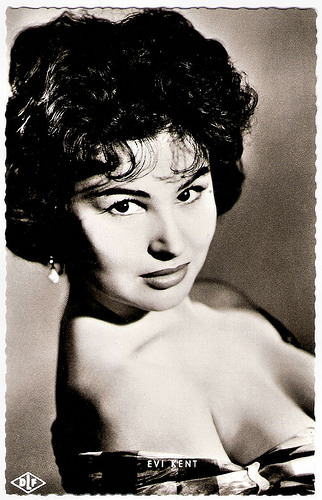
German postcard by Kunst und Bild, Berlin, no. I 493. Photo: Filmaufbau / Deutsche London / Lindner. Publicity still for Friederike von Barring (Rolf Thiele, 1956).
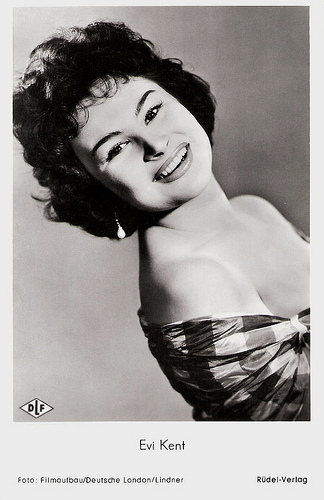
German postcard by F.J. Rüdel, Filmpostkartenverlag, Hamburg-Bergedorf, no. 1773. Photo: Filmaufbau / Deutsche London / Lindner. Publicity still for Friederike von Barring (Rolf Thiele, 1956).
Fluffy and Forgettable
For four years Evi Kent did not appear in films, but in 1961 she played small parts in the Austrian comedy Unsere tollen Tanten/Our Mad Aunts (Rolf Olsen, 1961) with Günter Philipp and Vivi Bach , and the sequel Unsere tollen Nichten/Our Mad Nieces (Rolf Olsen, 1962).
During the early 1960s, she appeared mainly in small roles in Austrian films: in comedies and Schlager films. Some titles are Das haben die Mädchen gern/That’s What the Girls Like (Kurt Nachmann, 1962) with Ann Smyrner , and Tanze mit mir in den Morgen/Dance with Me Into the Morning (Peter Dörre, 1962) with Rex Gildo .
She also played the female lead in the adventure comedy Unter Wasser küßt man nicht/Under Water One Doesn’t Kiss (Erich Heindl, 1962) opposite Gunther Philipp. It would not become her breakthrough role, and in the following years her parts in films became smaller.
Those films included Rote Lippen soll man küssen/Red Lips Should Be Kissed (Franz Antel, 1963) starring Johanna Matz , Allotria in Zell am See/Larking about in Zell am See (Franz Marischka, 1963) and Jetzt dreht die Welt sich nur um dich/The World Turns Around Now (Wolfgang Liebeneiner, 1964), all fluffy and forgettable.
Evi found bigger roles in comedies on television, like next to Hannelore Auer in Eheinstitut Harmonie/Marriage Institute Harmony (Dieter Pröttel, 1964), in Mitternachtszauber/Midnight Magic (Ralph Lothar, 1964) with Beppo Brem, and in Der doppelte Moritz/Thre Double Moritz (Fred Kraus, 1966) starring popular comedian Willy Millowitsch.
She often performed as a singer on TV, like in the Silvester Show (Dieter Pröttel, 1964) and Es funkeln die Sterne - Eine musikalische Silvesterreise um die Welt/Stars Twinkle - A Musical Christmas Trip Around the World (Paul Martin, Dieter Wendrich, 1966).
The following years her appearances became rarer. On TV she was seen next to Georg Thomalla in an episode of Komische Geschichten mit Georg Thomalla/Funny Stories With Georg Thomalla, and in the musical Auf der grünen Wiese/At the Green Meadow (Edwin Zbonek, 1971).
In the cinema she was last seen in Blau blüht der Enzian/Blue Blossoms the Gentian (Franz Antel, 1973), a comedy set in the winter resort of Kitzbühel in Tyrol, Austria, starring TV host Ilja Richter. On television she was last seen in an episode of the Austrian TV series Alfred auf Reisen/Afred on Voyage (1982, Kurt Junek, Hemut Pfandler) featuring Alfred Böhm.
And from then on all traces of beautiful Evi Kent disappeared…
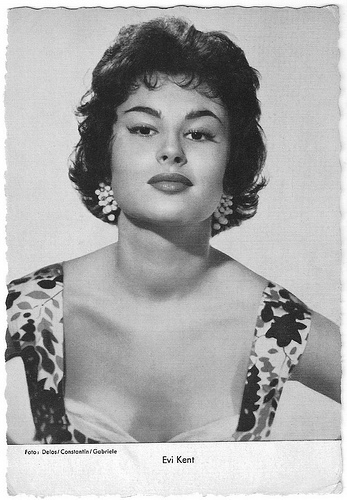
German postcard by WS-Druck,Wanne-Eickel. Photo: Delos / Constantin/Gabriele.
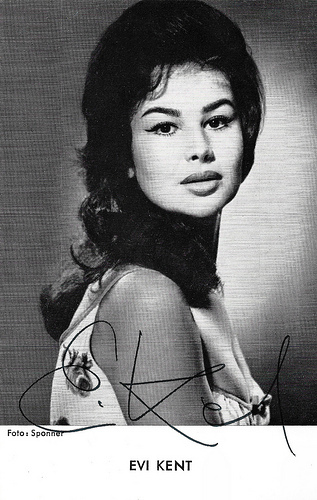
German autograph card. Photo: Sponner.
Evi Kent sings Warum drehn' sich alle Männer nach mir um? (1956). Source: Blackeyedjoe (YouTube).
Evi Kent sings Mauerblümchen (1956). Source: Blackeyedjoe (YouTube).
Sources: BlackeyedJoe (YouTube) and .

Dutch postcard by P. Moorlag, Heerlen, Sort 14/6. Photo: E. Schneider.
Wallflower
Evi Kent was born in Brünn, Austria (now Brno, Czech Republic) in 1938.
According to the IMDb , Evi Kent’s first appearances were in 1953 on German television, in the comedy Spiel mit dem Glück/Love Game (Peter A. Horn, 1953) and in the musical show Knallbonbons (Hanns Farenburg, 1953).
From early on she worked both as an actress and a singer. In Spiel mit dem Glück, the Trinidad born singer Mona Baptiste starred and Evi was billed fourth. In Knallbonbons some then well-known artists performed like Belgian singer-actress Angèle Durand and the dance group The Hiller Girls.
Evi’s appearances must have been successful, while in the following years some supporting roles followed in theatrical films like the comedy Mamitschka (Rolf Thiele, 1955) starring Rudolf Platte , Friederike von Barring (Rolf Thiele, 1956) starring Nadja Tiller , Mein Vater, der Schauspieler/My Father, the Actor (Robert Siodmak, 1956) with O.W. Fischer , and Jede Nacht in einem anderen Bett/Each Night in Another bed (Paul Verhoeven, 1957) with Gerhard Riedmann .
Among her hit songs was Papa Tanzt Mambo, a German cover of Perry Como's Papa Loves Mambo, which decades later re-appeared on compilations like 100 Goldene Schlager 1930-1955. In 1956 she also made a great German cover version of Teresa Brewer’s hit A Sweet Old Fashioned Girl: Mauerblümchen (Wallflower) - genuine German Rock and Roll.
That same year she also sang the cheeky and equally enjoyable Warum drehn' sich alle Männer nach mir um? (Why Do All the Men Turn Around for Me?). Both can be heard on YouTube (and thanks to Blackeyedjoe also here below).

German postcard by Kunst und Bild, Berlin, no. I 493. Photo: Filmaufbau / Deutsche London / Lindner. Publicity still for Friederike von Barring (Rolf Thiele, 1956).

German postcard by F.J. Rüdel, Filmpostkartenverlag, Hamburg-Bergedorf, no. 1773. Photo: Filmaufbau / Deutsche London / Lindner. Publicity still for Friederike von Barring (Rolf Thiele, 1956).
Fluffy and Forgettable
For four years Evi Kent did not appear in films, but in 1961 she played small parts in the Austrian comedy Unsere tollen Tanten/Our Mad Aunts (Rolf Olsen, 1961) with Günter Philipp and Vivi Bach , and the sequel Unsere tollen Nichten/Our Mad Nieces (Rolf Olsen, 1962).
During the early 1960s, she appeared mainly in small roles in Austrian films: in comedies and Schlager films. Some titles are Das haben die Mädchen gern/That’s What the Girls Like (Kurt Nachmann, 1962) with Ann Smyrner , and Tanze mit mir in den Morgen/Dance with Me Into the Morning (Peter Dörre, 1962) with Rex Gildo .
She also played the female lead in the adventure comedy Unter Wasser küßt man nicht/Under Water One Doesn’t Kiss (Erich Heindl, 1962) opposite Gunther Philipp. It would not become her breakthrough role, and in the following years her parts in films became smaller.
Those films included Rote Lippen soll man küssen/Red Lips Should Be Kissed (Franz Antel, 1963) starring Johanna Matz , Allotria in Zell am See/Larking about in Zell am See (Franz Marischka, 1963) and Jetzt dreht die Welt sich nur um dich/The World Turns Around Now (Wolfgang Liebeneiner, 1964), all fluffy and forgettable.
Evi found bigger roles in comedies on television, like next to Hannelore Auer in Eheinstitut Harmonie/Marriage Institute Harmony (Dieter Pröttel, 1964), in Mitternachtszauber/Midnight Magic (Ralph Lothar, 1964) with Beppo Brem, and in Der doppelte Moritz/Thre Double Moritz (Fred Kraus, 1966) starring popular comedian Willy Millowitsch.
She often performed as a singer on TV, like in the Silvester Show (Dieter Pröttel, 1964) and Es funkeln die Sterne - Eine musikalische Silvesterreise um die Welt/Stars Twinkle - A Musical Christmas Trip Around the World (Paul Martin, Dieter Wendrich, 1966).
The following years her appearances became rarer. On TV she was seen next to Georg Thomalla in an episode of Komische Geschichten mit Georg Thomalla/Funny Stories With Georg Thomalla, and in the musical Auf der grünen Wiese/At the Green Meadow (Edwin Zbonek, 1971).
In the cinema she was last seen in Blau blüht der Enzian/Blue Blossoms the Gentian (Franz Antel, 1973), a comedy set in the winter resort of Kitzbühel in Tyrol, Austria, starring TV host Ilja Richter. On television she was last seen in an episode of the Austrian TV series Alfred auf Reisen/Afred on Voyage (1982, Kurt Junek, Hemut Pfandler) featuring Alfred Böhm.
And from then on all traces of beautiful Evi Kent disappeared…

German postcard by WS-Druck,Wanne-Eickel. Photo: Delos / Constantin/Gabriele.

German autograph card. Photo: Sponner.
Evi Kent sings Warum drehn' sich alle Männer nach mir um? (1956). Source: Blackeyedjoe (YouTube).
Evi Kent sings Mauerblümchen (1956). Source: Blackeyedjoe (YouTube).
Sources: BlackeyedJoe (YouTube) and .
Published on November 18, 2017 22:00
November 17, 2017
Erika Remberg (1932-2017)
It's sad to read that Erika Remberg passed away last week, on 10 November 2017. Long ago we saw the beautiful Austrian film actress in the tearjerker Laila/Make Way for Lila (Rolf Husberg, 1958), as a foundling who is adopted and raised by a Lapland chieftain. Remberg appeared in 31 films between 1950 and 1970, but we want to remember her as lovely Laila.
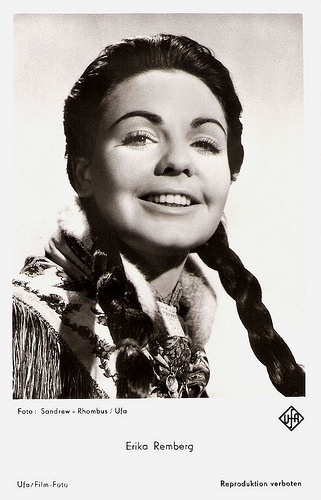
German postcard by Ufa, Berlin-Tempelhof, no. FK 4340. Photo: Sandrew / Rhombus / Ufa. Publicity still for Laila/Make Way for Lila (Rolf Husberg, 1958).
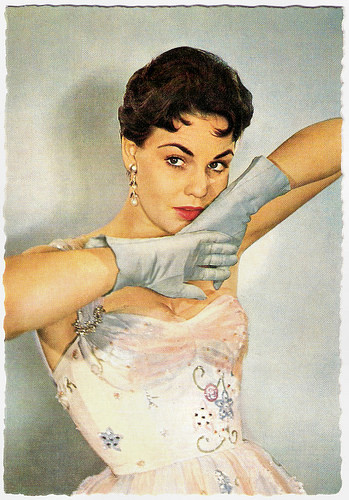
German postcard by WS-Drück, Wanne-Eickel, no. F 100. Photo: Huster.
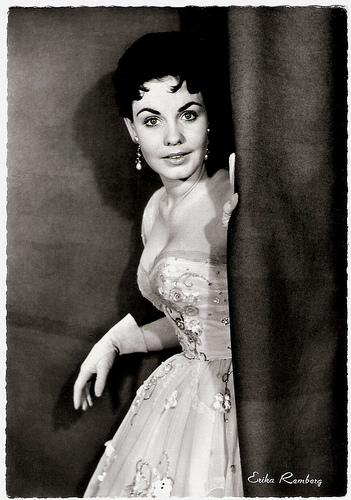
German postcard by Bartoschek-Verlag, Stuttgart-Bad Canstatt, no. 1443. Photo: Huster.
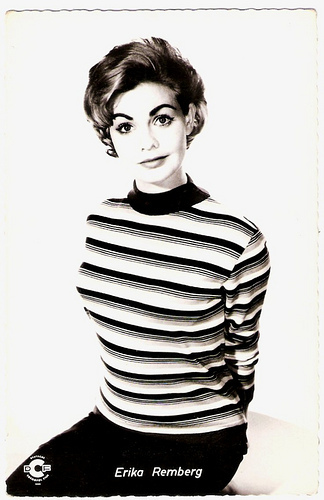
German postcard by Kolibri-Verlag G.m.b.H., Minden-Westf., no. 630. Photo: Deutsche Cosmopol. Publicity photo for the comedy Lockvogel der Nacht/Decoys of the Night (Wilm ten Haaf, 1959).
Turkish Production
Erika Remberg was born Erika Crobath in 1932 in Medan, on the island of Sumatra in the Dutch Indies (now Indonesia). She was the daughter of a tobacco planter. The family returned to Austria during the Second World War.
Erika visited a gymnasium in Innsbruck and there she had her first stage experiences as an amateur actress. After some acting classes and small engagements she worked for the Exl-Bühne in Innsbruck.
There she met Austrian actor Walter Reyer and they married in 1950. That same year their daughter Veronika was born.
In 1950 she also made her film debut in the drama Der Geigenmacher von Mittenwald/The violin maker from Mittenwald (Rudolf Schündler, 1950) with Paul Richter .
Small roles followed in films like the comedy Drei Kavaliere/Three Cavaliers (Joe Stöckel, 1951) and the circus film Salto Mortale (Viktor Tourjansky, 1953), starring Margot Hielscher and Philip Dorn .
As the leading lady, she first appeared in the title role of the Turkish production Nilgün (Münir Hayri Egeli, 1954).
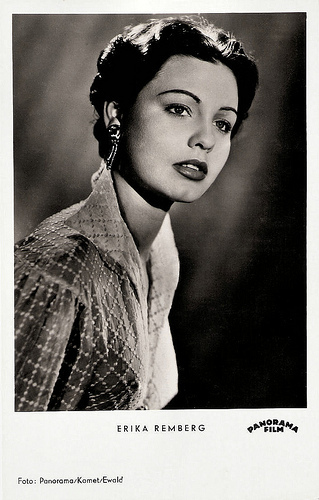
German postcard by Kunst und Bild, Berlin, no. A 778. Photo: Panorama / Komet / Ewald. Publicity still for Salto Mortale (Viktor Tourjansky, 1953).
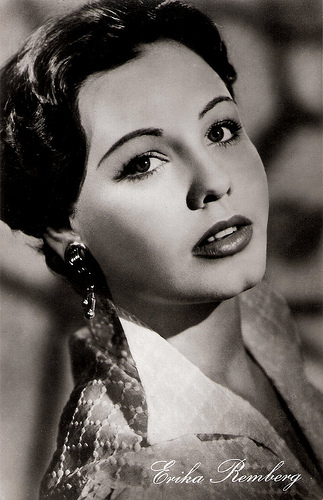
East-German postcard by VEB Progress Film-Vertrieb, Berlin, no. 444, 1957. Photo: Komet-Film. Publicity still for Salto Mortale (Viktor Tourjansky, 1953).
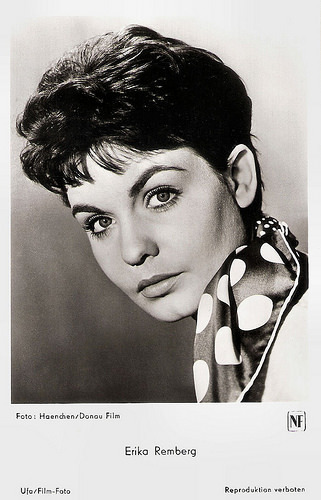
German postcard by Ufa, Berlin-Tempelhof, no. FK 3123. Photo: Haenchen / Donau Film. Publicity still for Rosmarie kommt aus Wildwest/Rosmarie comes from Wild West (Wolfgang Becker, 1956).

German postcard by Ufa, Berlin-Tempelhof, no. FK 3342. Photo: Michaelis / Sascha/ Herzog Film. Publicity still for Kaiserjäger/Emperor hunters (Willi Forst, 1956).
Laila
After the Exl-Bühne stopped, Erika Remberg focused completely on the cinema. She became the life partner of the German film actor Klaus Kinski in 1955 and soon she became a star of the German cinema of the late 1950s.
She was the leading lady in such films as the Western comedy Rosmarie kommt aus Wildwest/Rosmarie Comes From the Wild West (Wolfgang Becker, 1956), and three Austrian romantic comedies with Adrian Hoven : Kaiserjäger (Willi Forst, 1956), Wien Du Stadt meiner Träume/Vienna, City of My Dreams (Willi Forst, 1957) and Die unentschuldigte Stunde/The Unexcused Hour (Willi Forst, 1957).
Most of these films were not very interesting artistically, but commercially they were successes. Her biggest hit was the Swedish-German co-production Laila/Make Way for Lila (Rolf Husberg, 1958).
It was the third film version of the tale of Laila, a foundling who is adopted and raised by a Lapland chieftain. Growing to maturity in the frozen Northlands, Laila enjoys an adventuresome existence. Obedient to her adoptive parents, Lila is prepared to settle down and marry the man of their choice - until she falls in love with handsome Joachim Hansen .
Hal Erickson at AllMovie : “Lively ‘mountain drama’ (…) evocatively photographed by Sven Nykvist”. Nykvist was the director of photography of many Ingmar Bergman films.
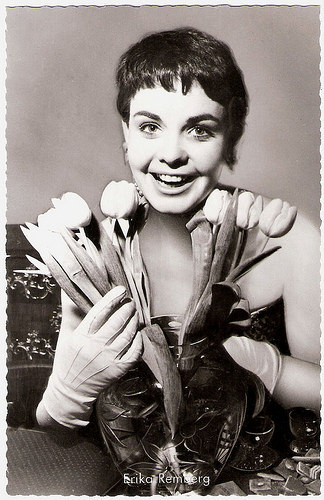
German postcard by Kolibri-Verlag G.m.b.H., Minden-Westf., no. 166.

German card by WS-Druck, Wanne-Eickel, no. 143. Photo: Matador-Film.
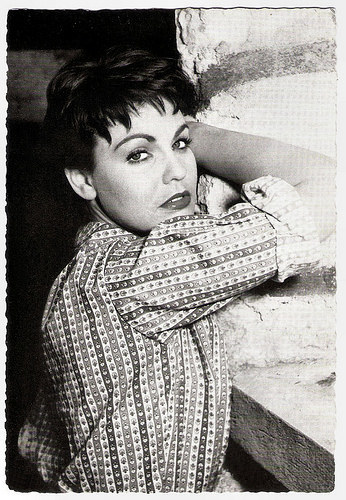
German postcard by WS-Drück, Wanne-Eickel, no. 406. Photo: Bavaria / Filmpress Zürich.

German postcard by Kolibri-Verlag G.m.b.H., Minden-Westf., no. 235. Photo: Kolibri / Enzwieser.
Circus of Horrors
In the 1960s, during the decline of the German cinema, Erika Remberg worked often internationally. In 1960 she starred in the Mexican thriller Verano violento/Violent Summer (Alfonso Corona Blake, 1960) opposite Pedro Armendariz. One of her other co-stars was Gustavo Rojo, whom she later married.
That same year she also starred in the French war drama Le bois des amants/Between Love and Duty (Claude Autant-Lara, 1960) with Laurent Terzieff , and in the British horror film Circus of Horrors (Sidney Hayers, 1960).
Circus of Horrors was the third of a series of creepy films from Amalgamated Studios focusing on sadism, cruelty and violence (with sexual undertones). The film details the twisted practises of a deranged German plastic surgeon (Anton Diffring) who hides out in France after mutilating a patient and begins his work anew under an assumed name, travelling with a circus troupe. The previous films in the trilogy were Horrors of the Black Museum and Peeping Tom, both in 1959.
During the 1960s, Erika Remberg mainly appeared on TV. In the cinema she played supporting parts in mediocre fare like the vampire film Der Fluch der grünen Augen/Cave of the Living Dead (Ákos Ráthonyi, 1964) with Adrian Hoven , and the drama À belles dents/Living it Up (Pierre Gaspard-Huit, 1966) starring Mireille Darc .
Her last film was the arty but interesting erotic film The Lickerish Quartet (Radley Metzger, 1970) with Frank Wolff. The reviewer at IMDb writes: “The narrative is interesting and full of tricks. It uses flashbacks, pseudo flashbacks and multiple perspectives. Yes, it's a bit pretentious, but the plot keeps you watching.”
In the USA, The Lickerish Quartet received critical praise upon its release by many critics, including Andy Warhol and Vincent Canby as being one of the first films with graphic sex to have Hollywood-like production values.
In later years, Erika Remberg mainly worked for TV in series like Wie würden Sie entscheiden?/How Would You Decide? (Clemens Keiffenheim, Renate Vacano, 1974) and Les grands détectives/The Great Detectives (Jean Herman, 1975).
Somewhere in the mid-1970s, she said the cinema and the stage farewell. In 1981 she wrote the novel Steckbriefe/Profiles, that was adapted into a TV series.
After this Erika Remberg retired completely and married film director Sidney Hayers, with whom she had made Circus of Horrors in 1960. They lived together in Altea, Spain, where Hayers died of cancer in 2000.

German postcard by Kolibri-Verlag G.m.b.H., Minden-Westf., no. 901. Photo: Deutsche Cosmopol. Publicity photo for the comedy Lockvogel der Nacht/Decoys of the Night (Wilm ten Haaf, 1959).
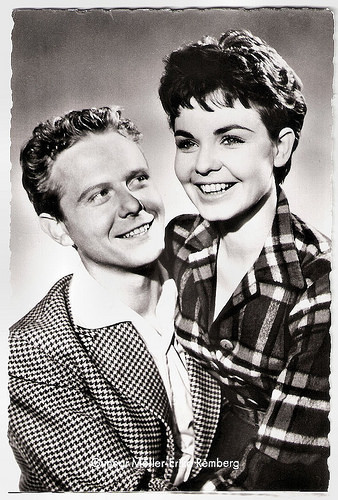
German postcard by Kolibri-Verlag G.m.b.H., Minden-Westf., no. 2838. Photo: publicity still for Drei weiße Birken/Three white birches (Hans Albin, 1961).
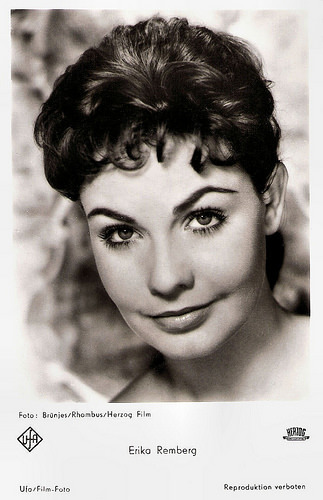
German postcard by Ufa, Berlin-Tempelhof, no. FK 3821. Photo: Brünjes / Rhombus / Ufa.
German Trailer of Laila/Make Way for Lila (1958). Source: Pidax (YouTube).
Trailer of Circus of Horrors (1960). Source: WickedVisionMagazin
(YouTube).
Trailer of The Lickerish Quartet (1970). Source: CultEpicsDVD (YouTube).
Sources: Hal Erickson (AllMovie), AllMovie, Wikipedia (German) and .

German postcard by Ufa, Berlin-Tempelhof, no. FK 4340. Photo: Sandrew / Rhombus / Ufa. Publicity still for Laila/Make Way for Lila (Rolf Husberg, 1958).

German postcard by WS-Drück, Wanne-Eickel, no. F 100. Photo: Huster.

German postcard by Bartoschek-Verlag, Stuttgart-Bad Canstatt, no. 1443. Photo: Huster.

German postcard by Kolibri-Verlag G.m.b.H., Minden-Westf., no. 630. Photo: Deutsche Cosmopol. Publicity photo for the comedy Lockvogel der Nacht/Decoys of the Night (Wilm ten Haaf, 1959).
Turkish Production
Erika Remberg was born Erika Crobath in 1932 in Medan, on the island of Sumatra in the Dutch Indies (now Indonesia). She was the daughter of a tobacco planter. The family returned to Austria during the Second World War.
Erika visited a gymnasium in Innsbruck and there she had her first stage experiences as an amateur actress. After some acting classes and small engagements she worked for the Exl-Bühne in Innsbruck.
There she met Austrian actor Walter Reyer and they married in 1950. That same year their daughter Veronika was born.
In 1950 she also made her film debut in the drama Der Geigenmacher von Mittenwald/The violin maker from Mittenwald (Rudolf Schündler, 1950) with Paul Richter .
Small roles followed in films like the comedy Drei Kavaliere/Three Cavaliers (Joe Stöckel, 1951) and the circus film Salto Mortale (Viktor Tourjansky, 1953), starring Margot Hielscher and Philip Dorn .
As the leading lady, she first appeared in the title role of the Turkish production Nilgün (Münir Hayri Egeli, 1954).

German postcard by Kunst und Bild, Berlin, no. A 778. Photo: Panorama / Komet / Ewald. Publicity still for Salto Mortale (Viktor Tourjansky, 1953).

East-German postcard by VEB Progress Film-Vertrieb, Berlin, no. 444, 1957. Photo: Komet-Film. Publicity still for Salto Mortale (Viktor Tourjansky, 1953).

German postcard by Ufa, Berlin-Tempelhof, no. FK 3123. Photo: Haenchen / Donau Film. Publicity still for Rosmarie kommt aus Wildwest/Rosmarie comes from Wild West (Wolfgang Becker, 1956).

German postcard by Ufa, Berlin-Tempelhof, no. FK 3342. Photo: Michaelis / Sascha/ Herzog Film. Publicity still for Kaiserjäger/Emperor hunters (Willi Forst, 1956).
Laila
After the Exl-Bühne stopped, Erika Remberg focused completely on the cinema. She became the life partner of the German film actor Klaus Kinski in 1955 and soon she became a star of the German cinema of the late 1950s.
She was the leading lady in such films as the Western comedy Rosmarie kommt aus Wildwest/Rosmarie Comes From the Wild West (Wolfgang Becker, 1956), and three Austrian romantic comedies with Adrian Hoven : Kaiserjäger (Willi Forst, 1956), Wien Du Stadt meiner Träume/Vienna, City of My Dreams (Willi Forst, 1957) and Die unentschuldigte Stunde/The Unexcused Hour (Willi Forst, 1957).
Most of these films were not very interesting artistically, but commercially they were successes. Her biggest hit was the Swedish-German co-production Laila/Make Way for Lila (Rolf Husberg, 1958).
It was the third film version of the tale of Laila, a foundling who is adopted and raised by a Lapland chieftain. Growing to maturity in the frozen Northlands, Laila enjoys an adventuresome existence. Obedient to her adoptive parents, Lila is prepared to settle down and marry the man of their choice - until she falls in love with handsome Joachim Hansen .
Hal Erickson at AllMovie : “Lively ‘mountain drama’ (…) evocatively photographed by Sven Nykvist”. Nykvist was the director of photography of many Ingmar Bergman films.

German postcard by Kolibri-Verlag G.m.b.H., Minden-Westf., no. 166.

German card by WS-Druck, Wanne-Eickel, no. 143. Photo: Matador-Film.

German postcard by WS-Drück, Wanne-Eickel, no. 406. Photo: Bavaria / Filmpress Zürich.

German postcard by Kolibri-Verlag G.m.b.H., Minden-Westf., no. 235. Photo: Kolibri / Enzwieser.
Circus of Horrors
In the 1960s, during the decline of the German cinema, Erika Remberg worked often internationally. In 1960 she starred in the Mexican thriller Verano violento/Violent Summer (Alfonso Corona Blake, 1960) opposite Pedro Armendariz. One of her other co-stars was Gustavo Rojo, whom she later married.
That same year she also starred in the French war drama Le bois des amants/Between Love and Duty (Claude Autant-Lara, 1960) with Laurent Terzieff , and in the British horror film Circus of Horrors (Sidney Hayers, 1960).
Circus of Horrors was the third of a series of creepy films from Amalgamated Studios focusing on sadism, cruelty and violence (with sexual undertones). The film details the twisted practises of a deranged German plastic surgeon (Anton Diffring) who hides out in France after mutilating a patient and begins his work anew under an assumed name, travelling with a circus troupe. The previous films in the trilogy were Horrors of the Black Museum and Peeping Tom, both in 1959.
During the 1960s, Erika Remberg mainly appeared on TV. In the cinema she played supporting parts in mediocre fare like the vampire film Der Fluch der grünen Augen/Cave of the Living Dead (Ákos Ráthonyi, 1964) with Adrian Hoven , and the drama À belles dents/Living it Up (Pierre Gaspard-Huit, 1966) starring Mireille Darc .
Her last film was the arty but interesting erotic film The Lickerish Quartet (Radley Metzger, 1970) with Frank Wolff. The reviewer at IMDb writes: “The narrative is interesting and full of tricks. It uses flashbacks, pseudo flashbacks and multiple perspectives. Yes, it's a bit pretentious, but the plot keeps you watching.”
In the USA, The Lickerish Quartet received critical praise upon its release by many critics, including Andy Warhol and Vincent Canby as being one of the first films with graphic sex to have Hollywood-like production values.
In later years, Erika Remberg mainly worked for TV in series like Wie würden Sie entscheiden?/How Would You Decide? (Clemens Keiffenheim, Renate Vacano, 1974) and Les grands détectives/The Great Detectives (Jean Herman, 1975).
Somewhere in the mid-1970s, she said the cinema and the stage farewell. In 1981 she wrote the novel Steckbriefe/Profiles, that was adapted into a TV series.
After this Erika Remberg retired completely and married film director Sidney Hayers, with whom she had made Circus of Horrors in 1960. They lived together in Altea, Spain, where Hayers died of cancer in 2000.

German postcard by Kolibri-Verlag G.m.b.H., Minden-Westf., no. 901. Photo: Deutsche Cosmopol. Publicity photo for the comedy Lockvogel der Nacht/Decoys of the Night (Wilm ten Haaf, 1959).

German postcard by Kolibri-Verlag G.m.b.H., Minden-Westf., no. 2838. Photo: publicity still for Drei weiße Birken/Three white birches (Hans Albin, 1961).

German postcard by Ufa, Berlin-Tempelhof, no. FK 3821. Photo: Brünjes / Rhombus / Ufa.
German Trailer of Laila/Make Way for Lila (1958). Source: Pidax (YouTube).
Trailer of Circus of Horrors (1960). Source: WickedVisionMagazin
(YouTube).
Trailer of The Lickerish Quartet (1970). Source: CultEpicsDVD (YouTube).
Sources: Hal Erickson (AllMovie), AllMovie, Wikipedia (German) and .
Published on November 17, 2017 22:00
November 16, 2017
Massilia
Massilia ia a little known French label, that published dozens of collectors cards during the 1930s, in colour (hand-coloured cards) and black and white, and in different formats. On 23 April 2012, EFSP did a post with Massilia cards from the collection of American collector Amit Benyovits. Today, a post with Massilia cards from our own collection.

Jean Gabin . French collectors card by Massilia.

Annabella . French collectors card by Massilia. Photo: Fox.

Fernandel . French collectors card by Massilia.
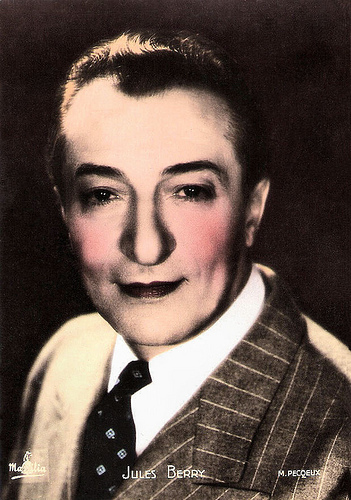
Jules Berry . French collectors card by Massilia.
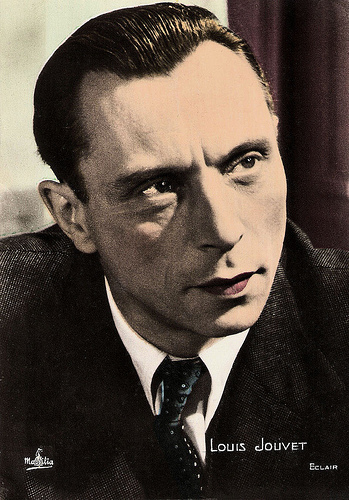
Louis Jouvet. French postcard by Massilia. Photo: Eclair.
A Greek Colony
Wikipedia mentions that Massilia is the Latin name of the Greek colony of Μασσαλία. It was founded by the Ionians of Phocaea in 600 BC. The colony was located on the southern coast of Gaul, at the place of modern Marseilles.
Massilia was also an affiliated label with bonbons Loriot (etablissements UNGEMAC Strasbourg) in the 1930s. Massilia issued ‘Sammelbilder’ (collectors cards) about various subjects, in different formats, in colour and in black and white or sepia.
Many labels used the collectors cards as a gift and promo for their products, including Kivou in Belgium (chocolate), and an incredible amount of cigarettes labels in Germany: Altona, Orami, and so on.
These labels often used Ross Verlag for their film stars albums. Other subjects for the collectors cards were dancers, beautiful women, animals, flags and martial subjects when the NSDAP took over in Germany.
Some of the Massilia cards are large sized (10,5 cm x 15 cm) and printed on high quality card stock. Others are smaller (8 x 11 cm). Almost all of them have vibrantly colour-toned images on front and plain white backs. But there are also series in black and white or sepia. On each card you’ll find a small Massilia logo at the bottom.
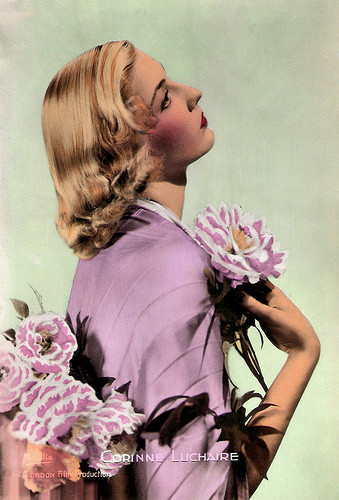
Corinne Luchaire . French collectors card by Massilia. Photo: London Film Productions.
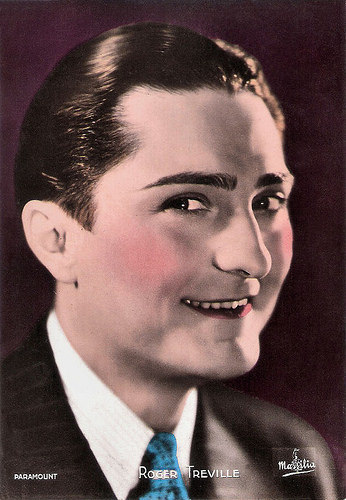
Roger Tréville . French collectors card by Massilia. Photo: Paramount.

Pierre Blanchar . French collectors card by Massilia. Photo: Filmsonor.

Michèle Morgan . French collectors card by Massilia. Photo: Osso.
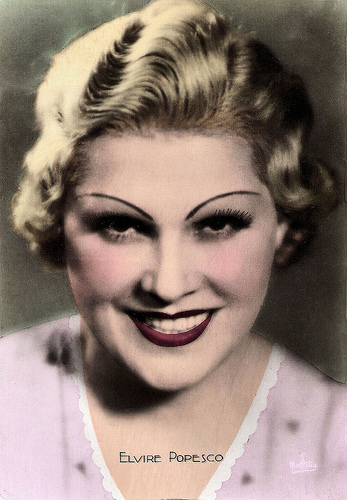
Elvire Popesco. French collectors card by Massilia.
Different Poses
At the memorabilia site Immortal Ephemera , Cliff Aliperti dates Amit Benyovits' set to approximately 1937-1938 due to inclusion of child stars such as Shirley Temple and Deanna Durbin. At Immortal Ephemera, you 'll find scans of the album cover plus of all the cards of Benyovits, including some cards of pairs.
Cliff Aliperti: “Of these pairs Yvette Lebon and Tino Rossi only appeared in one film together, released 1936; Viviane Romance and Tino Rossi appeared in 2, released in 1937 and much later (1972). Also included are the pair of Jacqueline Delubac and Sacha Guitry who appeared in a whopping 11 films together: 1 in 1935, the other 10 all between 1936-1938.”
Some of the photos look a lot like pictures you can see on similar postcards of other publishers, but the poses are different. What could be the reason?
Collector Didier Hanson: “Keep in mind that 9 times out of 10 the photo atelier took many shots during the photo session, and many or all of them were used to issue postcards, even if the publishers were different. This explains why you can come across similar postcards from different publishing houses.”
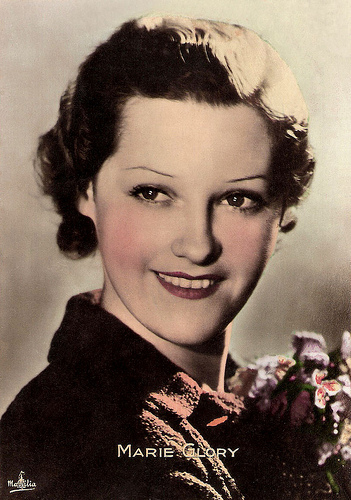
Marie Glory . French card by Massilia.

Armand Bernard . French card by Massilia. Photo: A.C.E.
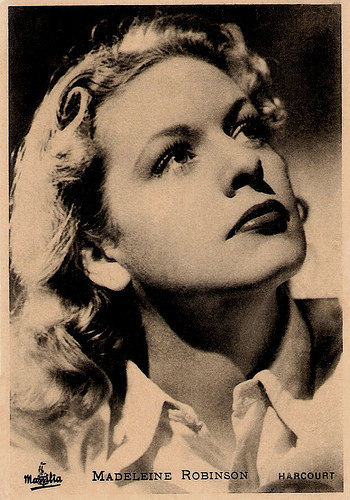
Madeleine Robinson . French collectors card by Massilia. Photo: Studio Harcourt.
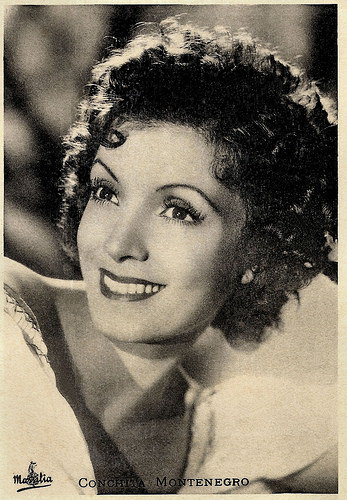
Conchita Montenegro . French collectors card by Massilia.
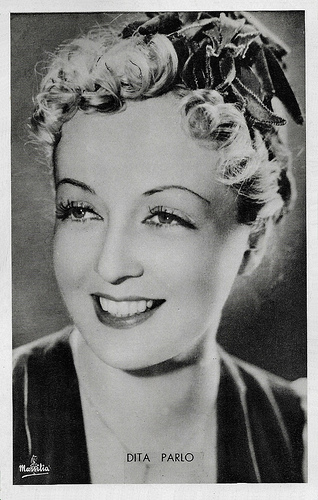
Dita Parlo . French collectors card by Massilia.
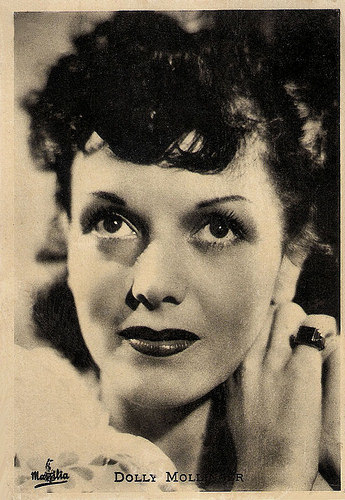
Dolly Mollinger . French collectors card by Massilia.
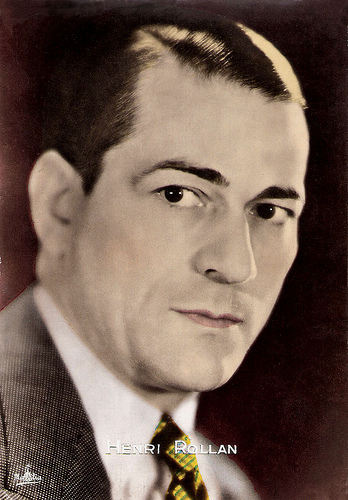
Henri Rollan . French card by Massilia. Handwritten text at the backside (not entirely readable): "Je suis heureux de pouvoir vous saluer de cette façon un peu inattendue.... aussi inconnue à qui sont dédiés mes efforts, mais qui en pensez... quoi??? Bien sympathiquement... quoi qu'il en soit. Henri Rollan".
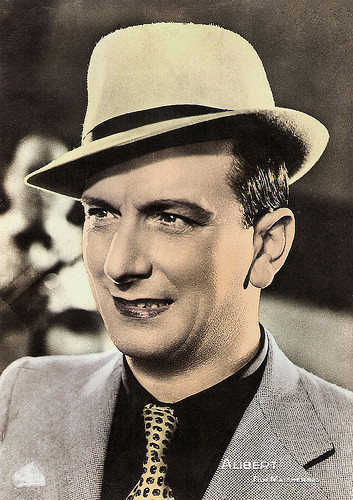
Henri Alibert . French card by Massilia. Photo: Film Malsherbes. Publicity still for Titin des Martigues (René Pujol, 1938).
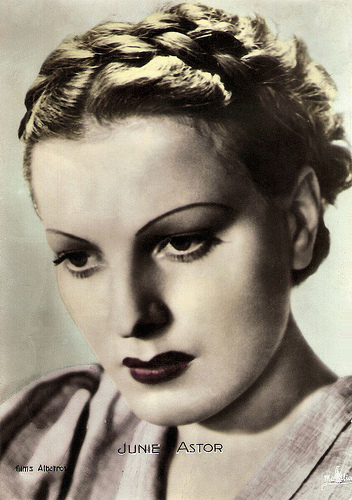
Junie Astor . French postcard by Massilia. Photo: Filma Albatros. Publicity still for Les Bas-fonds/The Lower Depths (Jean Renoir, 1936).
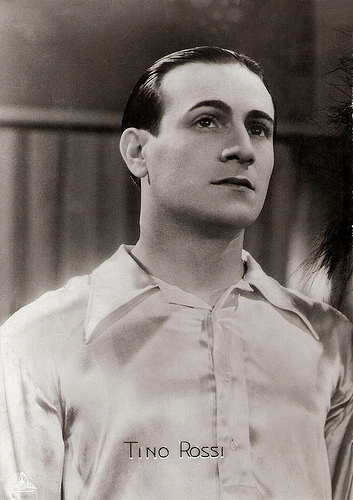
Tino Rossi. French card by Massilia.
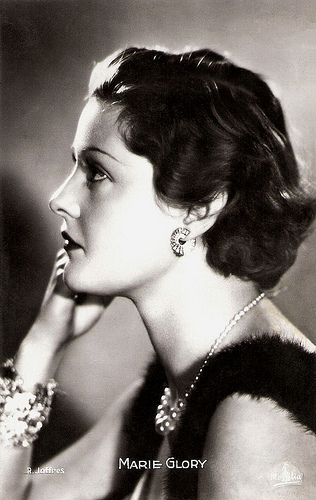
Marie Glory . French card by Massilia. Photo: R. Joffres.

René Dary . French collectors card by Massilia. Photo: Léo Mirkine.
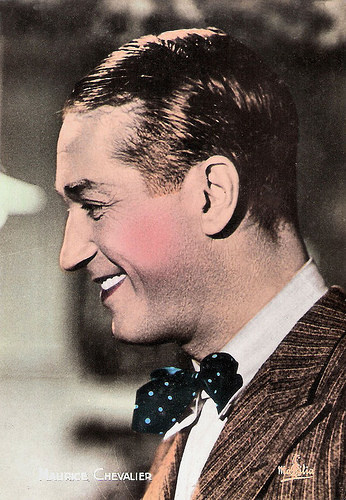
Maurice Chevalier . French collectors card by Massilia.
Sources: Didier Hanson, Amit Benyovits, Clifford Aliperti (Immortal Ephemera), and Wikipedia.
It is Postcard Friendship Friday, hosted by Beth at the The Best Hearts are Crunchy. You can visit her by clicking on the button below.


Jean Gabin . French collectors card by Massilia.

Annabella . French collectors card by Massilia. Photo: Fox.

Fernandel . French collectors card by Massilia.

Jules Berry . French collectors card by Massilia.

Louis Jouvet. French postcard by Massilia. Photo: Eclair.
A Greek Colony
Wikipedia mentions that Massilia is the Latin name of the Greek colony of Μασσαλία. It was founded by the Ionians of Phocaea in 600 BC. The colony was located on the southern coast of Gaul, at the place of modern Marseilles.
Massilia was also an affiliated label with bonbons Loriot (etablissements UNGEMAC Strasbourg) in the 1930s. Massilia issued ‘Sammelbilder’ (collectors cards) about various subjects, in different formats, in colour and in black and white or sepia.
Many labels used the collectors cards as a gift and promo for their products, including Kivou in Belgium (chocolate), and an incredible amount of cigarettes labels in Germany: Altona, Orami, and so on.
These labels often used Ross Verlag for their film stars albums. Other subjects for the collectors cards were dancers, beautiful women, animals, flags and martial subjects when the NSDAP took over in Germany.
Some of the Massilia cards are large sized (10,5 cm x 15 cm) and printed on high quality card stock. Others are smaller (8 x 11 cm). Almost all of them have vibrantly colour-toned images on front and plain white backs. But there are also series in black and white or sepia. On each card you’ll find a small Massilia logo at the bottom.

Corinne Luchaire . French collectors card by Massilia. Photo: London Film Productions.

Roger Tréville . French collectors card by Massilia. Photo: Paramount.

Pierre Blanchar . French collectors card by Massilia. Photo: Filmsonor.

Michèle Morgan . French collectors card by Massilia. Photo: Osso.

Elvire Popesco. French collectors card by Massilia.
Different Poses
At the memorabilia site Immortal Ephemera , Cliff Aliperti dates Amit Benyovits' set to approximately 1937-1938 due to inclusion of child stars such as Shirley Temple and Deanna Durbin. At Immortal Ephemera, you 'll find scans of the album cover plus of all the cards of Benyovits, including some cards of pairs.
Cliff Aliperti: “Of these pairs Yvette Lebon and Tino Rossi only appeared in one film together, released 1936; Viviane Romance and Tino Rossi appeared in 2, released in 1937 and much later (1972). Also included are the pair of Jacqueline Delubac and Sacha Guitry who appeared in a whopping 11 films together: 1 in 1935, the other 10 all between 1936-1938.”
Some of the photos look a lot like pictures you can see on similar postcards of other publishers, but the poses are different. What could be the reason?
Collector Didier Hanson: “Keep in mind that 9 times out of 10 the photo atelier took many shots during the photo session, and many or all of them were used to issue postcards, even if the publishers were different. This explains why you can come across similar postcards from different publishing houses.”

Marie Glory . French card by Massilia.

Armand Bernard . French card by Massilia. Photo: A.C.E.

Madeleine Robinson . French collectors card by Massilia. Photo: Studio Harcourt.

Conchita Montenegro . French collectors card by Massilia.

Dita Parlo . French collectors card by Massilia.

Dolly Mollinger . French collectors card by Massilia.

Henri Rollan . French card by Massilia. Handwritten text at the backside (not entirely readable): "Je suis heureux de pouvoir vous saluer de cette façon un peu inattendue.... aussi inconnue à qui sont dédiés mes efforts, mais qui en pensez... quoi??? Bien sympathiquement... quoi qu'il en soit. Henri Rollan".

Henri Alibert . French card by Massilia. Photo: Film Malsherbes. Publicity still for Titin des Martigues (René Pujol, 1938).

Junie Astor . French postcard by Massilia. Photo: Filma Albatros. Publicity still for Les Bas-fonds/The Lower Depths (Jean Renoir, 1936).

Tino Rossi. French card by Massilia.

Marie Glory . French card by Massilia. Photo: R. Joffres.

René Dary . French collectors card by Massilia. Photo: Léo Mirkine.

Maurice Chevalier . French collectors card by Massilia.
Sources: Didier Hanson, Amit Benyovits, Clifford Aliperti (Immortal Ephemera), and Wikipedia.
It is Postcard Friendship Friday, hosted by Beth at the The Best Hearts are Crunchy. You can visit her by clicking on the button below.

Published on November 16, 2017 22:00
November 15, 2017
Guglielmo Oberdan, il martire di Trieste (1915)
In 1882, Guglielmo Oberdan was executed after a failed attempt to assassinate Austrian Emperor Francis Joseph. He became a martyr of the Italian unification movement. Thirty years later, silent film star Alberto Collo played him in Guglielmo Oberdan, il martire di Trieste/Guglielmo Oberdan, the martyr of Trieste (Emilio Ghione, 1915), produced by Tiber Films during World War I. Viva L'Italia!

Italian postcard for Guglielmo Oberdan, il martire di Trieste (Emilio Ghione, 1915) with Alberto Collo as Gugliemo Oberdan and Vittorina Moneta as his fiancee Maria. Caption: "The Fatherland above all other affections. From this wet nurse Rome, queen of the world, the spark will part that will free my Trieste."
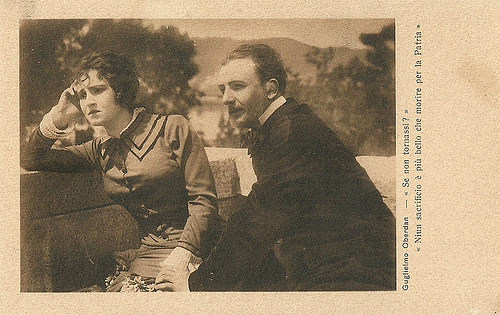
Italian postcard for Guglielmo Oberdan, il martire di Trieste (Emilio Ghione, 1915) with Alberto Collo and Vittorina Moneta. Caption: And if you don't return? There is no nicer sacrifice than dying for the fatherland.
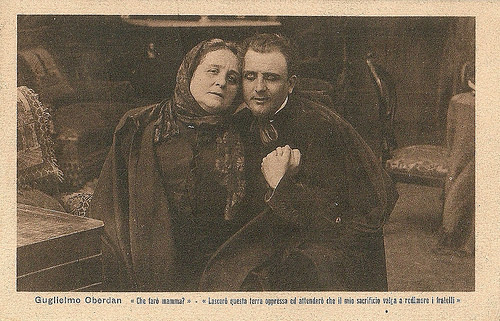
Italian postcard for Guglielmo Oberdan, il martire di Trieste (Emilio Ghione, 1915), with Alberto Collo as Oberdan and famous stage actress Ida Carloni Talli as his mother. Caption: "What shall I do, mamma? I will leave this oppressed land and will take care my sacrifice will be worthwhile to redeem my brothers and sisters."
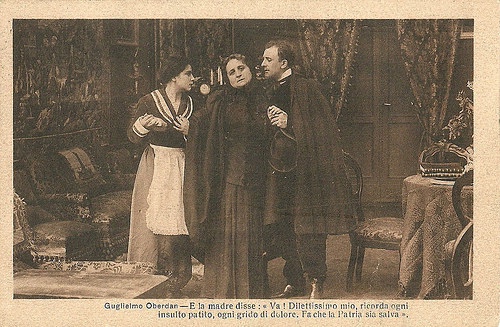
Italian postcard for Guglielmo Oberdan, il martire di Trieste (Emilio Ghione, 1915), with Alberto Collo as Oberdan and Ida Carloni Talli as his mother. Caption: "And his mother said: 'Go! My most beloved one, remember every suffered insult, every cry of grief. Make sure that the Fatherland will be saved'."
Propaganda
During the First World War, more postcards were mailed than ever before - or ever after. Different European countries decided to use the postcard to advertise films and to create film stars. Governments used the cinema as part of their propaganda machines. Italian producers chose the martyrs of the Italian liberation, like Guglielmo Oberdan, for their patriotic films to justify Italy's participation in the Great War.
Wilhelm Oberdan was born in the city of Trieste, then part of the Austrian Empire. His mother was a Slovene woman from Šempas in the County of Gorizia and Gradisca, while his father, Valentino Falcier, was a Venetian soldier in the Austrian army. He did not recognize his son, so Wilhelm took his mother's surname. He was educated in an Italian cultural milieu and Italianised his name to Guglielmo Oberdan.
In 1877 he enrolled at the Vienna's College of Technology (now Vienna University of Technology) where he studied engineering. As he supported the idea of independence for all of the empire's national groups he resented the occupation of Bosnia-Herzegovina by Austria-Hungary and therefore deserted from the Austro-Hungarian Army because he did not want to take part in military activities there.
Instead, he fled to Rome to continue his studies there. In the Italian capital he adopted irredentist ideas, aiming at the annexation to Italy of the Italian-speaking lands still under Austro-Hungarian rule. In 1882 he met with irredentist leader and co-founder Matteo Renato Imbriani. It was then that he came to the conviction that only radical acts of martyrdom could bring the liberation of Trieste from Austrian rule. And at the same time, Emperor Franz Joseph was planning a visit to Trieste as part of the celebration of the 500th anniversary of Habsburg dominion over the city...
Oberdan and Istrian pharmacist Donato Ragosa plotted an assassination attempt on the Emperor. However, their attempt failed. Oberdan was arrested and sentenced to hang by an Austrian court. His mother, author Victor Hugo and poet Giosue Carducci appealed for clemency - but in vain. Just before the execution, Oberdan cried "Viva l'Italia!" (Long live Italy!), which helped establish his later reputation as a martyr of the Italian National cause. Statues of him were erected throughout unified Italy. The Emperor Franz Joseph, who reigned another thirty-five years, never visited Trieste again. The assassination of Archduke Franz Ferdinand in 1914, harked back to Oberdan's earlier attempt.
Tiber Films produced Guglielmo Oberdan, il martire di Trieste in 1915. Director of this film adaptation of Oberdan's life was Emilio Ghione , who also played the role of the governor of Trieste. Ghione met the irredentist Gabriele D'Annunzio at an invitational showing of the film in Rome and Ghione's inter-titles were praised by D'Annunzio. Guglielmo Oberdan, il martire di Trieste was just one of a number of irredentist films produced in Italy during World War One. In our coming film special next week, EFSP will feature another example of these patriotic films.
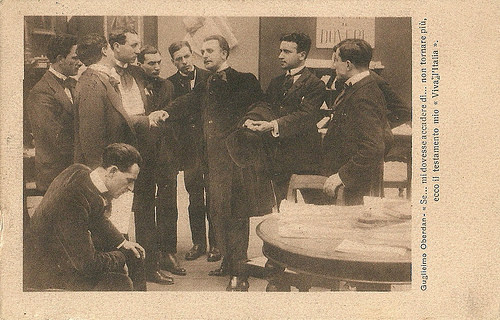
Italian postcard for Guglielmo Oberdan, il martire di Trieste (Emilio Ghione 1915), with Alberto Collo as Oberdan. Caption: "If it would happen... that I would not return ... here is my testament: Viva L'Italia!"
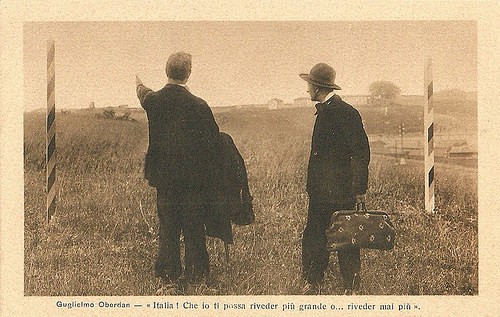
Italian postcard for Guglielmo Oberdan, il martire di Trieste (Emilio Ghione, 1915) with Alberto Collo as Guglielmo Obedan. Caption: Italy! May I see you again having grown bigger... or never see you again.
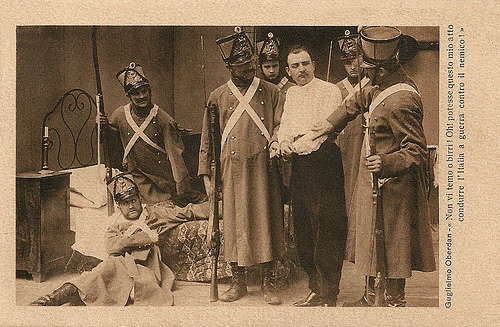
Italian postcard for Guglielmo Oberdan, il martire di Trieste (Emilio Ghione, 1915) with Alberto Collo as Guglielmo Obedan. Caption: "I don't fear you, you cops. If only my act could cause Italy to start war with the enemy."
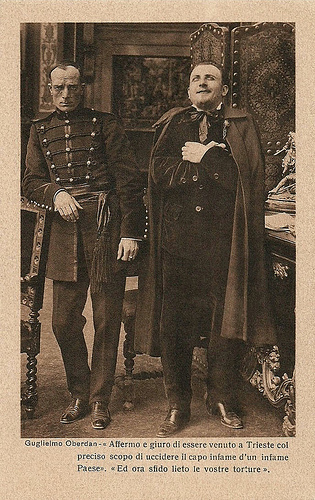
Italian postcard for Guglielmo Oberdan, il martire di Trieste (Emilio Ghione 1915), with Alberto Collo (right) as Guglielmo Oberdan (right) and Emilio Ghione (left) as the governor of Trieste. Caption: "I admit and I swear to have come to Trieste with the exact scope of killing the infamous head of an infamous state. And now I happily challenge your tortures."
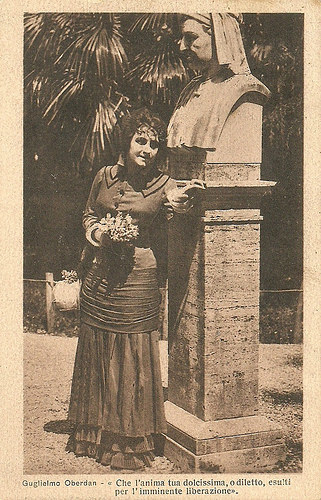
Italian postcard for Guglielmo Oberdan, il martire di Trieste (Emilio Ghione 1915), with Vittorina Moneta as Oberdan's fiancee Maria. Caption: "Let your sweet, delightful soul exult for the imminent liberation."
Sources: Wikipedia and IMDb

Italian postcard for Guglielmo Oberdan, il martire di Trieste (Emilio Ghione, 1915) with Alberto Collo as Gugliemo Oberdan and Vittorina Moneta as his fiancee Maria. Caption: "The Fatherland above all other affections. From this wet nurse Rome, queen of the world, the spark will part that will free my Trieste."

Italian postcard for Guglielmo Oberdan, il martire di Trieste (Emilio Ghione, 1915) with Alberto Collo and Vittorina Moneta. Caption: And if you don't return? There is no nicer sacrifice than dying for the fatherland.

Italian postcard for Guglielmo Oberdan, il martire di Trieste (Emilio Ghione, 1915), with Alberto Collo as Oberdan and famous stage actress Ida Carloni Talli as his mother. Caption: "What shall I do, mamma? I will leave this oppressed land and will take care my sacrifice will be worthwhile to redeem my brothers and sisters."

Italian postcard for Guglielmo Oberdan, il martire di Trieste (Emilio Ghione, 1915), with Alberto Collo as Oberdan and Ida Carloni Talli as his mother. Caption: "And his mother said: 'Go! My most beloved one, remember every suffered insult, every cry of grief. Make sure that the Fatherland will be saved'."
Propaganda
During the First World War, more postcards were mailed than ever before - or ever after. Different European countries decided to use the postcard to advertise films and to create film stars. Governments used the cinema as part of their propaganda machines. Italian producers chose the martyrs of the Italian liberation, like Guglielmo Oberdan, for their patriotic films to justify Italy's participation in the Great War.
Wilhelm Oberdan was born in the city of Trieste, then part of the Austrian Empire. His mother was a Slovene woman from Šempas in the County of Gorizia and Gradisca, while his father, Valentino Falcier, was a Venetian soldier in the Austrian army. He did not recognize his son, so Wilhelm took his mother's surname. He was educated in an Italian cultural milieu and Italianised his name to Guglielmo Oberdan.
In 1877 he enrolled at the Vienna's College of Technology (now Vienna University of Technology) where he studied engineering. As he supported the idea of independence for all of the empire's national groups he resented the occupation of Bosnia-Herzegovina by Austria-Hungary and therefore deserted from the Austro-Hungarian Army because he did not want to take part in military activities there.
Instead, he fled to Rome to continue his studies there. In the Italian capital he adopted irredentist ideas, aiming at the annexation to Italy of the Italian-speaking lands still under Austro-Hungarian rule. In 1882 he met with irredentist leader and co-founder Matteo Renato Imbriani. It was then that he came to the conviction that only radical acts of martyrdom could bring the liberation of Trieste from Austrian rule. And at the same time, Emperor Franz Joseph was planning a visit to Trieste as part of the celebration of the 500th anniversary of Habsburg dominion over the city...
Oberdan and Istrian pharmacist Donato Ragosa plotted an assassination attempt on the Emperor. However, their attempt failed. Oberdan was arrested and sentenced to hang by an Austrian court. His mother, author Victor Hugo and poet Giosue Carducci appealed for clemency - but in vain. Just before the execution, Oberdan cried "Viva l'Italia!" (Long live Italy!), which helped establish his later reputation as a martyr of the Italian National cause. Statues of him were erected throughout unified Italy. The Emperor Franz Joseph, who reigned another thirty-five years, never visited Trieste again. The assassination of Archduke Franz Ferdinand in 1914, harked back to Oberdan's earlier attempt.
Tiber Films produced Guglielmo Oberdan, il martire di Trieste in 1915. Director of this film adaptation of Oberdan's life was Emilio Ghione , who also played the role of the governor of Trieste. Ghione met the irredentist Gabriele D'Annunzio at an invitational showing of the film in Rome and Ghione's inter-titles were praised by D'Annunzio. Guglielmo Oberdan, il martire di Trieste was just one of a number of irredentist films produced in Italy during World War One. In our coming film special next week, EFSP will feature another example of these patriotic films.

Italian postcard for Guglielmo Oberdan, il martire di Trieste (Emilio Ghione 1915), with Alberto Collo as Oberdan. Caption: "If it would happen... that I would not return ... here is my testament: Viva L'Italia!"

Italian postcard for Guglielmo Oberdan, il martire di Trieste (Emilio Ghione, 1915) with Alberto Collo as Guglielmo Obedan. Caption: Italy! May I see you again having grown bigger... or never see you again.

Italian postcard for Guglielmo Oberdan, il martire di Trieste (Emilio Ghione, 1915) with Alberto Collo as Guglielmo Obedan. Caption: "I don't fear you, you cops. If only my act could cause Italy to start war with the enemy."

Italian postcard for Guglielmo Oberdan, il martire di Trieste (Emilio Ghione 1915), with Alberto Collo (right) as Guglielmo Oberdan (right) and Emilio Ghione (left) as the governor of Trieste. Caption: "I admit and I swear to have come to Trieste with the exact scope of killing the infamous head of an infamous state. And now I happily challenge your tortures."

Italian postcard for Guglielmo Oberdan, il martire di Trieste (Emilio Ghione 1915), with Vittorina Moneta as Oberdan's fiancee Maria. Caption: "Let your sweet, delightful soul exult for the imminent liberation."
Sources: Wikipedia and IMDb
Published on November 15, 2017 22:00
November 14, 2017
Claude France
Claude France (1893-1928) was a star of the French silent cinema of the 1920s. Two months before her greatest triumph opened in the cinemas, she committed suicide by opening the gas.
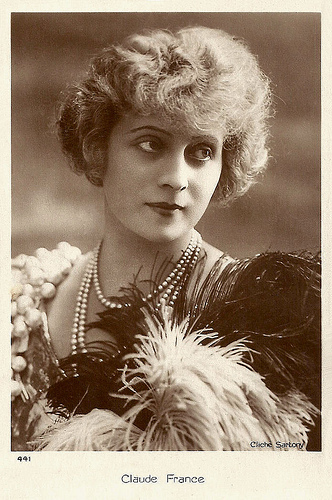
French postcard by Editions Cinémagazine no. 441. Photo: Sartony.

French postcard postcard by JRPR, Paris, no. 115. Photo: France-Film. Publicity still for L'île d'amour/Island of Love (Berte Dagmar, Jean Durand, 1929).

Belgian postcard by Weekblad Cinema, Antwerpen.
Memorable Films
Claude France was born Jane Joséphine Anna Françoise Wittig in Emden, Germany, in 1893.
In 1920, she made her cinema debut opposite Paul Capellani and Jaque Catelain in Le Carnaval des Vérités/The carnival of the truths by Marcel L'Herbier.
Afterwards she performed in such memorable films as Le Père Goriot/Father Goriot (Jacques de Baroncelli, 1921) after Honoré de Balzac, Le Diamant vert/The Green Diamond (Pierre Marodon, 1922), Pax Domine (René Leprince, 1923) with Camille Bert, and Violettes impériales/Imperial violet (Henry Roussel, 1923) with the temperamental Spanish star Raquel Meller .
In Germany she appeared in Moderne Ehen/Modern marriages (Hans Otto, 1924) with Helena Makowska , and in Pension Groonen (Robert Wiene, 1925) with Carmen Cartellieri . Back in France she worked on Le prince charmant/Prince Charming (Viktor Tourjansky, 1925) opposite Jaque Catelain , Le Bossu/The hunchback (Jean Kemm, 1925) featuring Gaston Jacquet, and L'Abbé Constantin/Abbot Constantin (Julien Duvivier, 1925) starring Jean Coquelin .
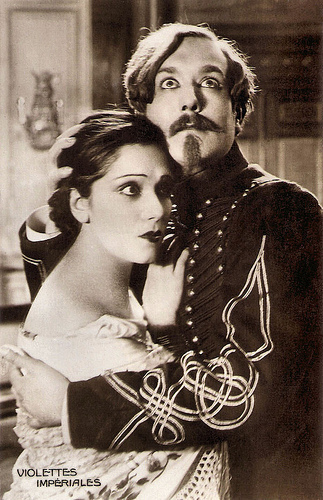
Raquel Meller and André Roanne . French postcard by Cinémagazine-Edition. Photo: publicity still for Violettes impériales/Imperial Violets (Henry Roussel, 1924).
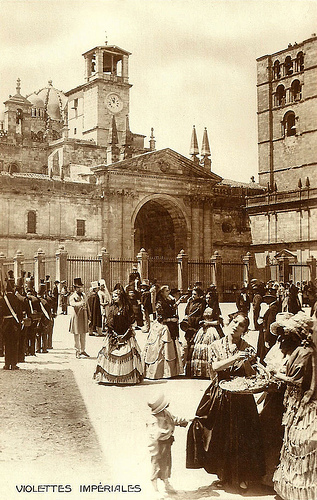
Raquel Meller . French postcard by Cinémagazine-Edition. Photo: publicity still for Violettes impériales/Imperial Violets (Henry Roussel, 1924).
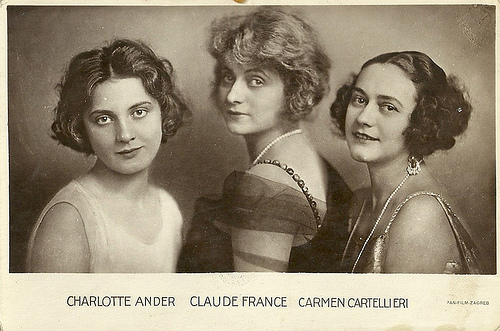
Charlotte Ander , Claude France, and Carmen Cartellieri . Croatian (former Jugoslavian) postcard by Pan-Film, Zagreb. Photo: publicity still for Pension Groonen (Robert Wiene, 1925).
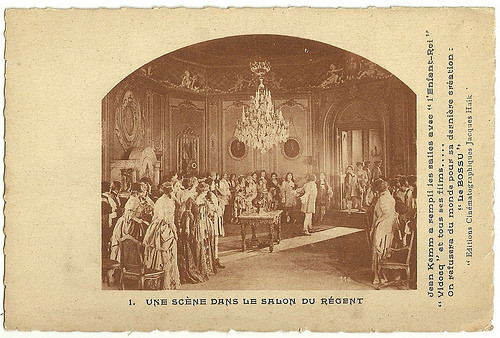
French postcard by Editions Cinématographiques Jacques Haïk, no. 1. Photo: publicity still for Le Bossu/The hunchback (Jean Kemm, 1925). Caption: Scene in the Salon of the Regent.
Madame de Pompadour
Claude France was very busy film actress in the mid-1920s. She played Madame de Pompadour in the adventure film Fanfan-la-Tulipe (Rene Leprince, 1925) featuring Aimé Simon-Girard , Potiphar's wife in Le berceau de dieu/The Cradle of God (Fred LeRoy Granville, 1926) with Léon Mathot , and the title character in Lady Harrington (Hewitt Claypoole Grantham-Hayes, Fred LeRoy Granville, 1926).
Then she had a double role as Mme Cornelis and Mme Termonde in André Cornelis (Jean Kemm, 1926), and she won the female leads in Simone (E.B. Donatien, 1926), and L'ile d'amour/Island of Love (Berthe Dagmar, Jean Durand, 1927), costarring Pierre Batcheff .
In January 1928, two months before her greatest triumph La Madone des Sleepings/Madonna of the Sleeping Cars (Marco de Gastyne, Maurice Gleize, 1928), costarring Olaf Fjord and Vladimir Gajdarov , would open in the cinemas, Claude France's career was cut short.
She committed suicide by opening the gas in her house in Paris. At his wonderful French blog Sniff & Puff , Tom Peeping writes that the press at the time wrote that she died because of a broken heart. Sniff & Puff presents a postcard of France with a dedication to her co-star of Le prince charmant/Prince Charming (1925), Jaque Catelain .
Was he also her dream prince charming in real life? If so, her dream must surely have become a deception: Catelain was gay and the lover of the director who gave France her first role, Marcel L'Herbier. Poor, sweet Claude France, she was only 34 at the time of her horrible death.
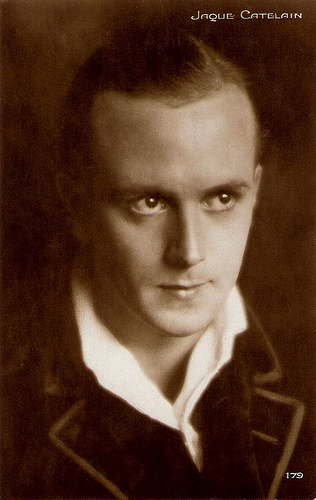
Jaque Catelain. French postcard by Cinémagazine, no. 179.
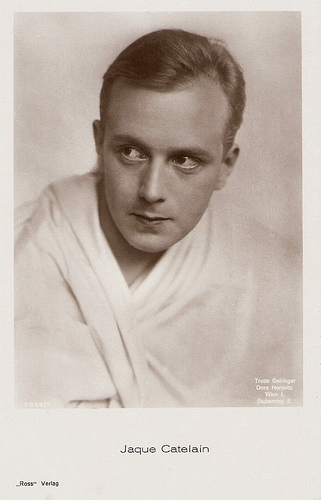
Jaque Catelain. German postcard by Ross Verlag, no. 1936/1, 1927/1928. Photo: Trude Heiringer, Dora Horovitz, Wien.
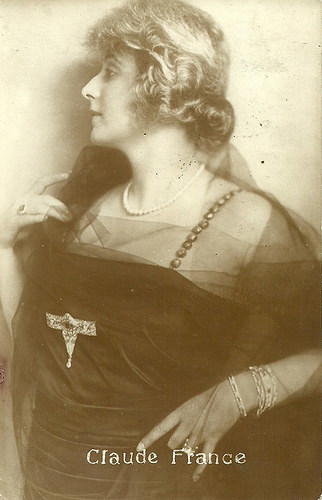
Romanian postcard
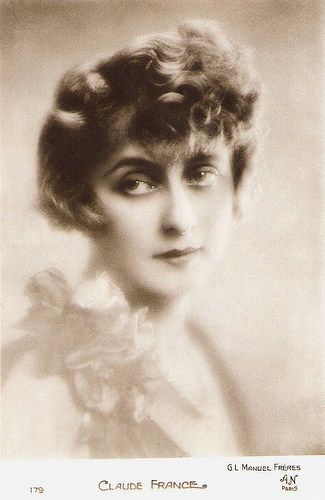
French postcard postcard in the Les Vedettes de Cinéma series by A.N., Paris, no. 179. Photo: G.L. Manuel Frères.
Sources: Sniff & Puff (French), Wikipedia (French), and .

French postcard by Editions Cinémagazine no. 441. Photo: Sartony.

French postcard postcard by JRPR, Paris, no. 115. Photo: France-Film. Publicity still for L'île d'amour/Island of Love (Berte Dagmar, Jean Durand, 1929).

Belgian postcard by Weekblad Cinema, Antwerpen.
Memorable Films
Claude France was born Jane Joséphine Anna Françoise Wittig in Emden, Germany, in 1893.
In 1920, she made her cinema debut opposite Paul Capellani and Jaque Catelain in Le Carnaval des Vérités/The carnival of the truths by Marcel L'Herbier.
Afterwards she performed in such memorable films as Le Père Goriot/Father Goriot (Jacques de Baroncelli, 1921) after Honoré de Balzac, Le Diamant vert/The Green Diamond (Pierre Marodon, 1922), Pax Domine (René Leprince, 1923) with Camille Bert, and Violettes impériales/Imperial violet (Henry Roussel, 1923) with the temperamental Spanish star Raquel Meller .
In Germany she appeared in Moderne Ehen/Modern marriages (Hans Otto, 1924) with Helena Makowska , and in Pension Groonen (Robert Wiene, 1925) with Carmen Cartellieri . Back in France she worked on Le prince charmant/Prince Charming (Viktor Tourjansky, 1925) opposite Jaque Catelain , Le Bossu/The hunchback (Jean Kemm, 1925) featuring Gaston Jacquet, and L'Abbé Constantin/Abbot Constantin (Julien Duvivier, 1925) starring Jean Coquelin .

Raquel Meller and André Roanne . French postcard by Cinémagazine-Edition. Photo: publicity still for Violettes impériales/Imperial Violets (Henry Roussel, 1924).

Raquel Meller . French postcard by Cinémagazine-Edition. Photo: publicity still for Violettes impériales/Imperial Violets (Henry Roussel, 1924).

Charlotte Ander , Claude France, and Carmen Cartellieri . Croatian (former Jugoslavian) postcard by Pan-Film, Zagreb. Photo: publicity still for Pension Groonen (Robert Wiene, 1925).

French postcard by Editions Cinématographiques Jacques Haïk, no. 1. Photo: publicity still for Le Bossu/The hunchback (Jean Kemm, 1925). Caption: Scene in the Salon of the Regent.
Madame de Pompadour
Claude France was very busy film actress in the mid-1920s. She played Madame de Pompadour in the adventure film Fanfan-la-Tulipe (Rene Leprince, 1925) featuring Aimé Simon-Girard , Potiphar's wife in Le berceau de dieu/The Cradle of God (Fred LeRoy Granville, 1926) with Léon Mathot , and the title character in Lady Harrington (Hewitt Claypoole Grantham-Hayes, Fred LeRoy Granville, 1926).
Then she had a double role as Mme Cornelis and Mme Termonde in André Cornelis (Jean Kemm, 1926), and she won the female leads in Simone (E.B. Donatien, 1926), and L'ile d'amour/Island of Love (Berthe Dagmar, Jean Durand, 1927), costarring Pierre Batcheff .
In January 1928, two months before her greatest triumph La Madone des Sleepings/Madonna of the Sleeping Cars (Marco de Gastyne, Maurice Gleize, 1928), costarring Olaf Fjord and Vladimir Gajdarov , would open in the cinemas, Claude France's career was cut short.
She committed suicide by opening the gas in her house in Paris. At his wonderful French blog Sniff & Puff , Tom Peeping writes that the press at the time wrote that she died because of a broken heart. Sniff & Puff presents a postcard of France with a dedication to her co-star of Le prince charmant/Prince Charming (1925), Jaque Catelain .
Was he also her dream prince charming in real life? If so, her dream must surely have become a deception: Catelain was gay and the lover of the director who gave France her first role, Marcel L'Herbier. Poor, sweet Claude France, she was only 34 at the time of her horrible death.

Jaque Catelain. French postcard by Cinémagazine, no. 179.

Jaque Catelain. German postcard by Ross Verlag, no. 1936/1, 1927/1928. Photo: Trude Heiringer, Dora Horovitz, Wien.

Romanian postcard

French postcard postcard in the Les Vedettes de Cinéma series by A.N., Paris, no. 179. Photo: G.L. Manuel Frères.
Sources: Sniff & Puff (French), Wikipedia (French), and .
Published on November 14, 2017 22:00
Paul van Yperen's Blog
- Paul van Yperen's profile
- 13 followers
Paul van Yperen isn't a Goodreads Author
(yet),
but they
do have a blog,
so here are some recent posts imported from
their feed.



